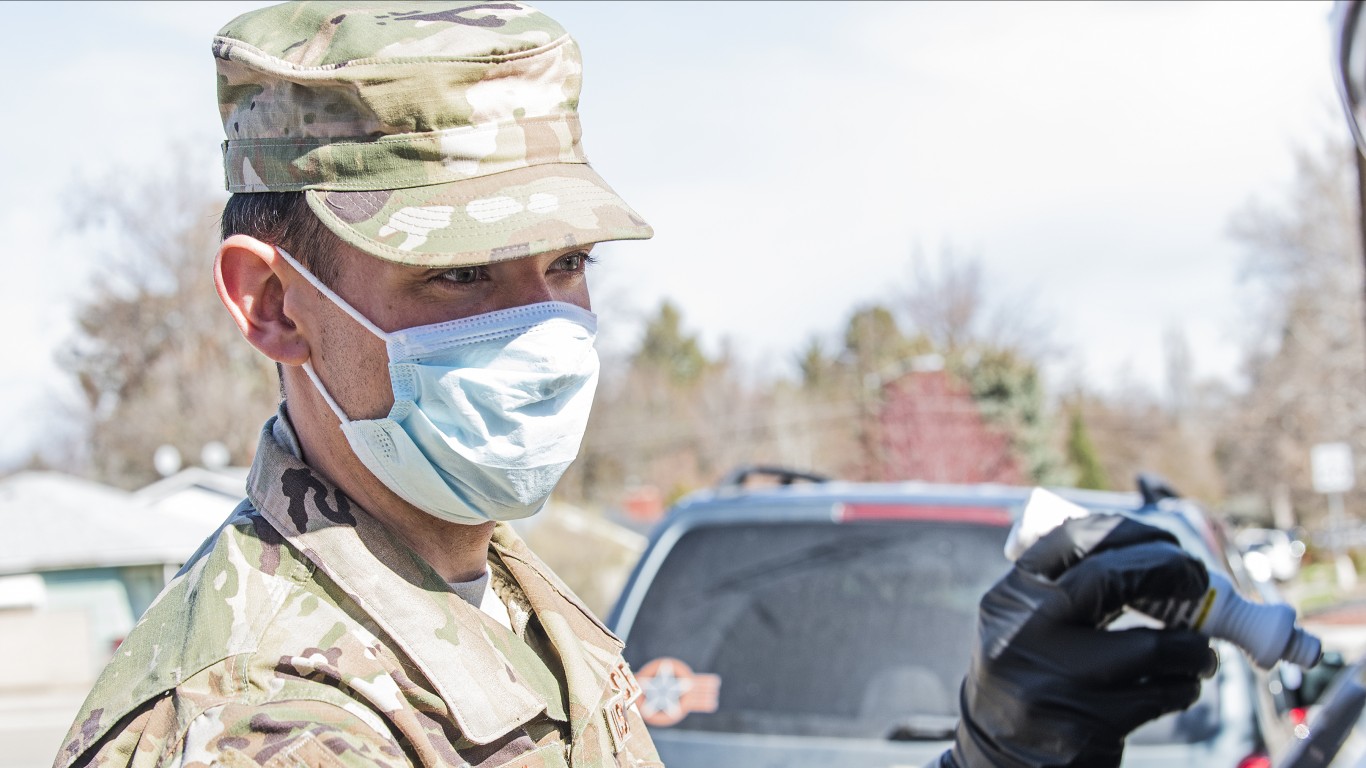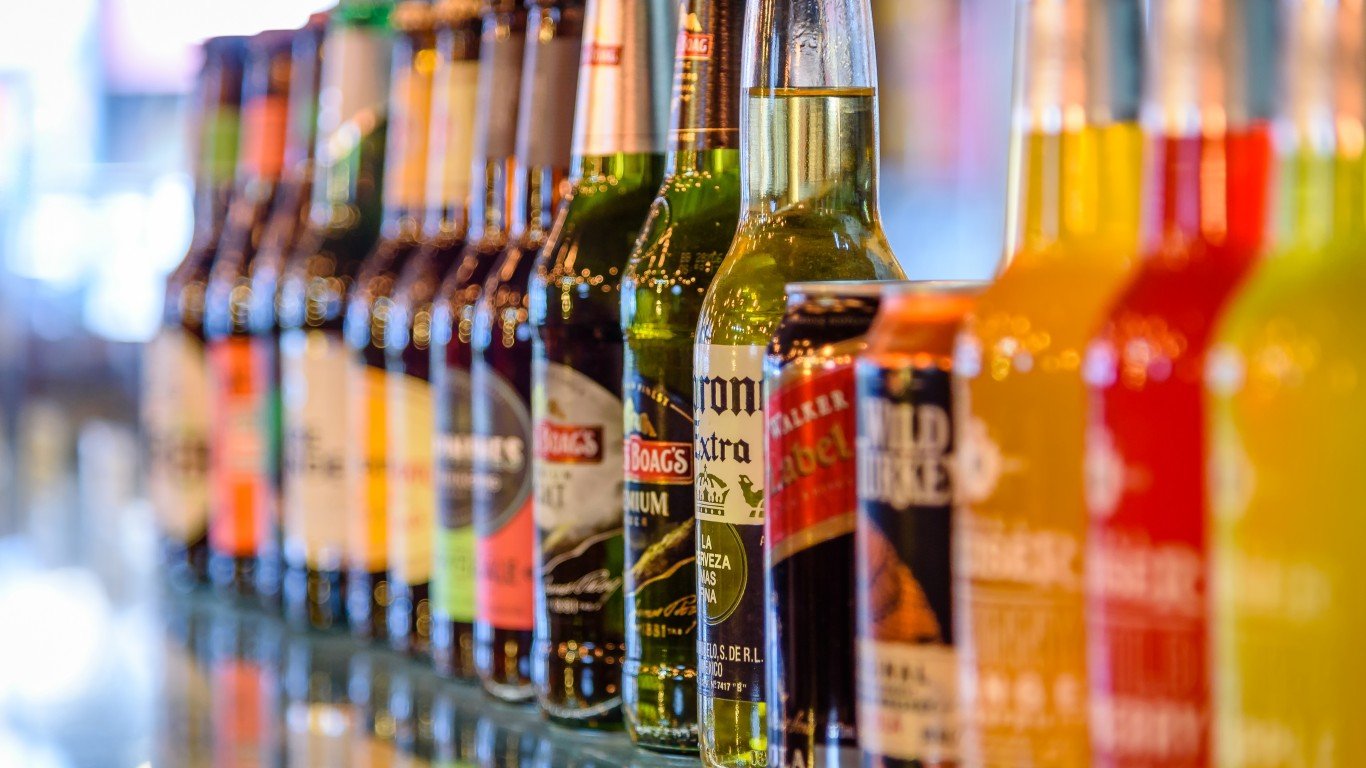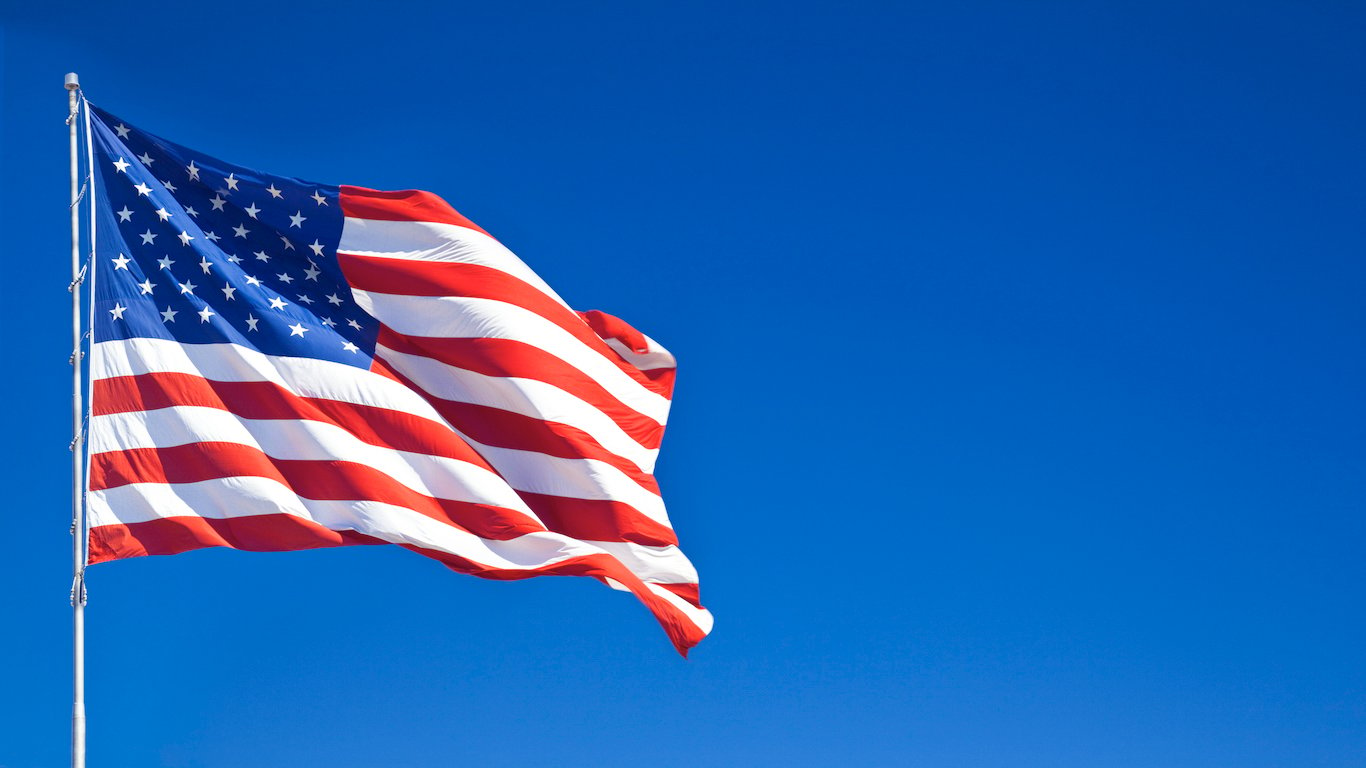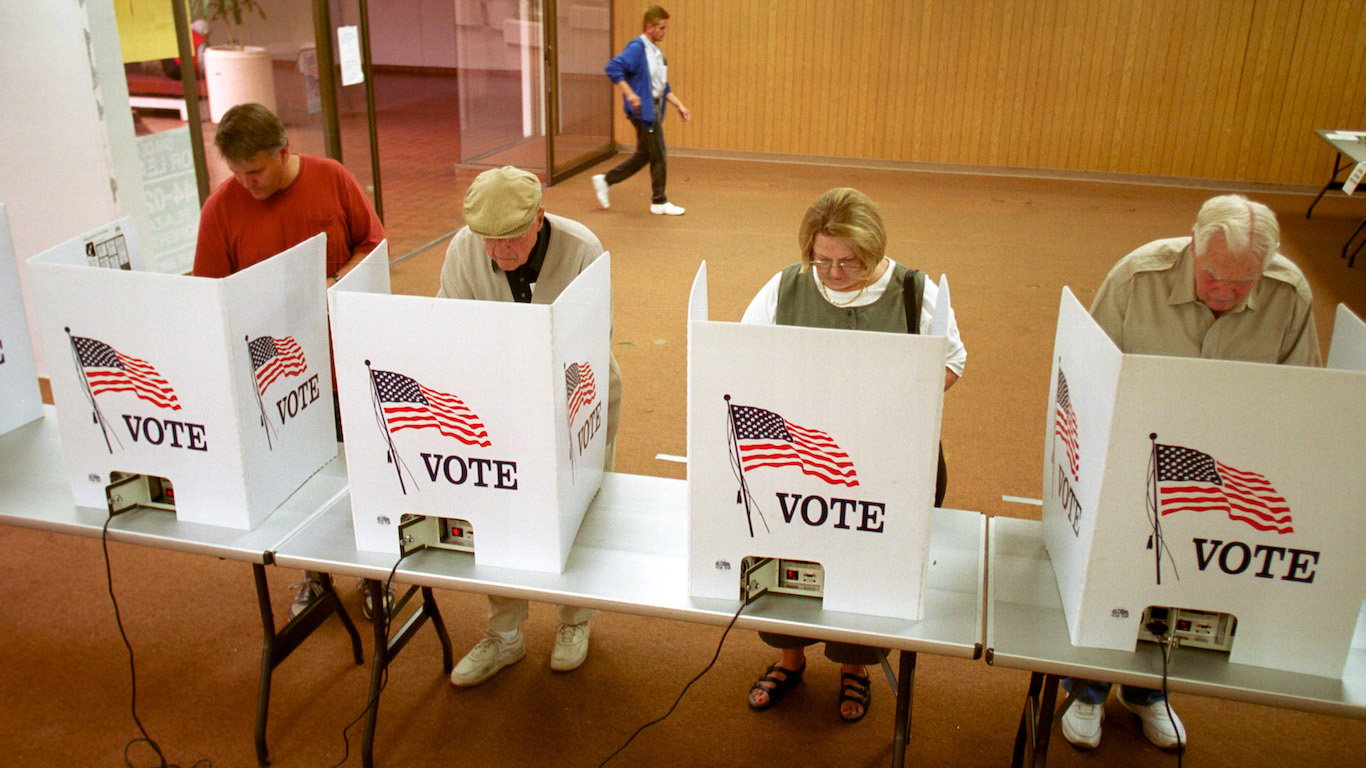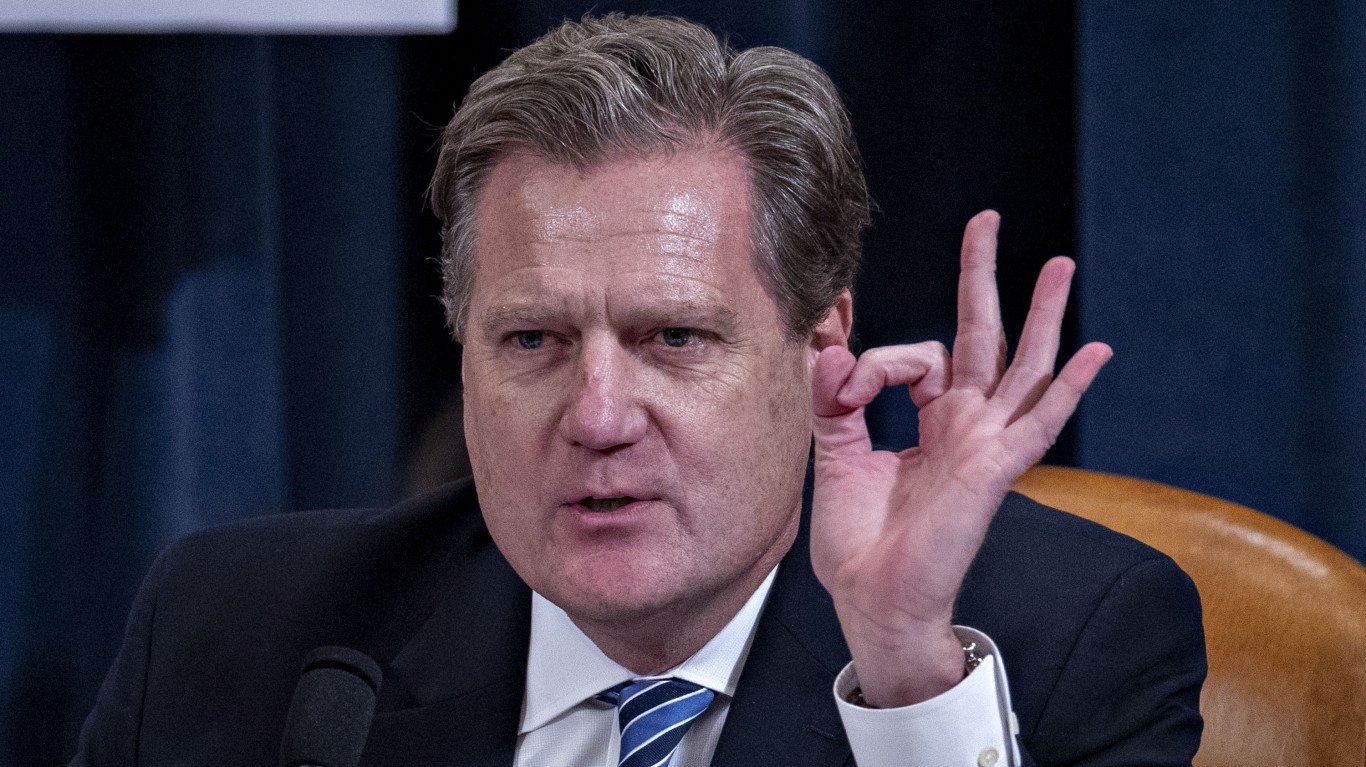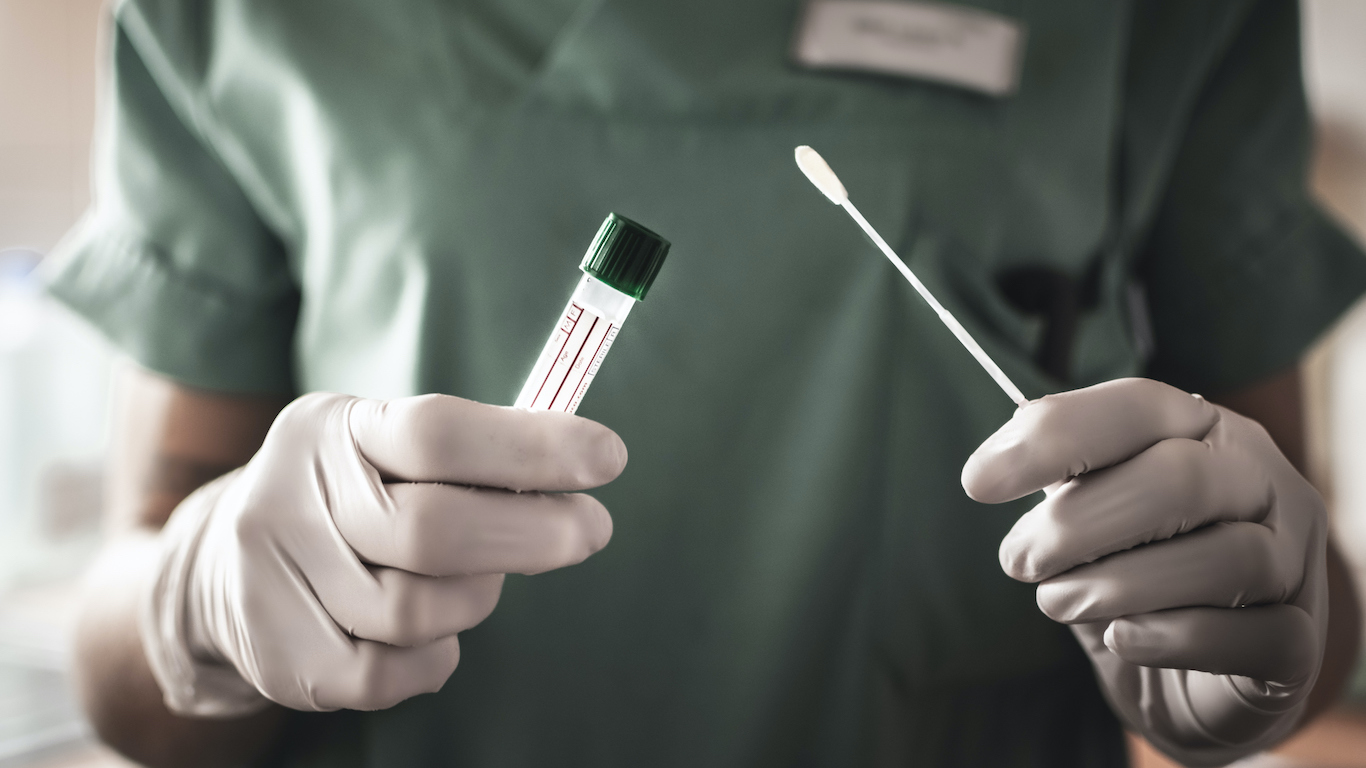

More than 1.3 million Americans have been infected with the coronavirus since the first case was confirmed in the U.S. on Jan. 21, 2020. From President Donald Trump down to state and local leaders, officials have compared the fight against COVID-19 to a war. Unlike a traditional wartime enemy, however, the virus is invisible — a complicating factor partially attributable to the woeful lack of testing capabilities in the United States.
Testing is a critical COVID-19 containment tool as it enables us to identify those who are infected and isolate them from healthy people. According to researchers at Harvard University, the U.S. needs to be able to conduct a minimum of about 152 daily tests for every 100,000 people in order to safely reopen the economy — a standard very few states are currently able to meet. Over the week ending on May 11, the average daily rate nationwide was just 92 tests administered for every 100,000 people.
24/7 Wall St. reviewed the average number of daily tests administered for every 100,000 people to determine how far off each state is for meeting the minimum recommended testing levels to safely reopen. In 20 states, average daily testing rates are less than half of what is recommended.
In an interview with 24/7 Wall St., Mark Siedner, associate professor of infectious diseases at Harvard University, laid out some of the reasons widespread testing takes time. Necessary levels of testing requires personnel to conduct and process the tests, machines to run specimens, and a reliable international supply chain. “You’re really asking the diagnostic community to go from zero to millions in a week or two,” Siedner said.
Testing efforts in the U.S. were initially slowed when the Centers for Disease Control and Prevention failed in its attempt to develop a working test for the virus. In response, the federal government lifted restrictions on March 3, allowing health care companies to develop and distribute their own tests.
Despite limited testing capabilities, many states are letting their stay-at-home orders expire and are easing other restrictions. Many experts fear that these premature reopenings will lead to a second wave of the virus. Here is when every state plans to lift COVID-19 restrictions.
“The worst thing that can happen is that we [reopen] blindly, without measuring its effects, clearly and carefully,” Siedner warned.
Click here to see all the states’ testing levels for COVID-19
Click here to read our methodology
50. Rhode Island
> Avg. daily tests as pct. of expert recommendation: 170.6%
> Avg. daily test rate from May 5 – May 11, 2020: 259.4 new tests per 100,000 people (2,742 tests per day)
> Positive test rate: 12.3% (19th highest)
> COVID-19 infection rate as of May 11, 2020: 1,082.9 per 100,000 people — 4th highest (11,450 total cases)
> COVID-19 death rate as of May 11, 2020: 40.7 per 100,000 people — 7th highest (430 total deaths)
> Cumulative tests performed as of May 11, 2020: 93,332 (21st fewest)
> Date of first case: March 1, 2020
> Total population: 1.1 million (7th fewest)
[in-text-ad]
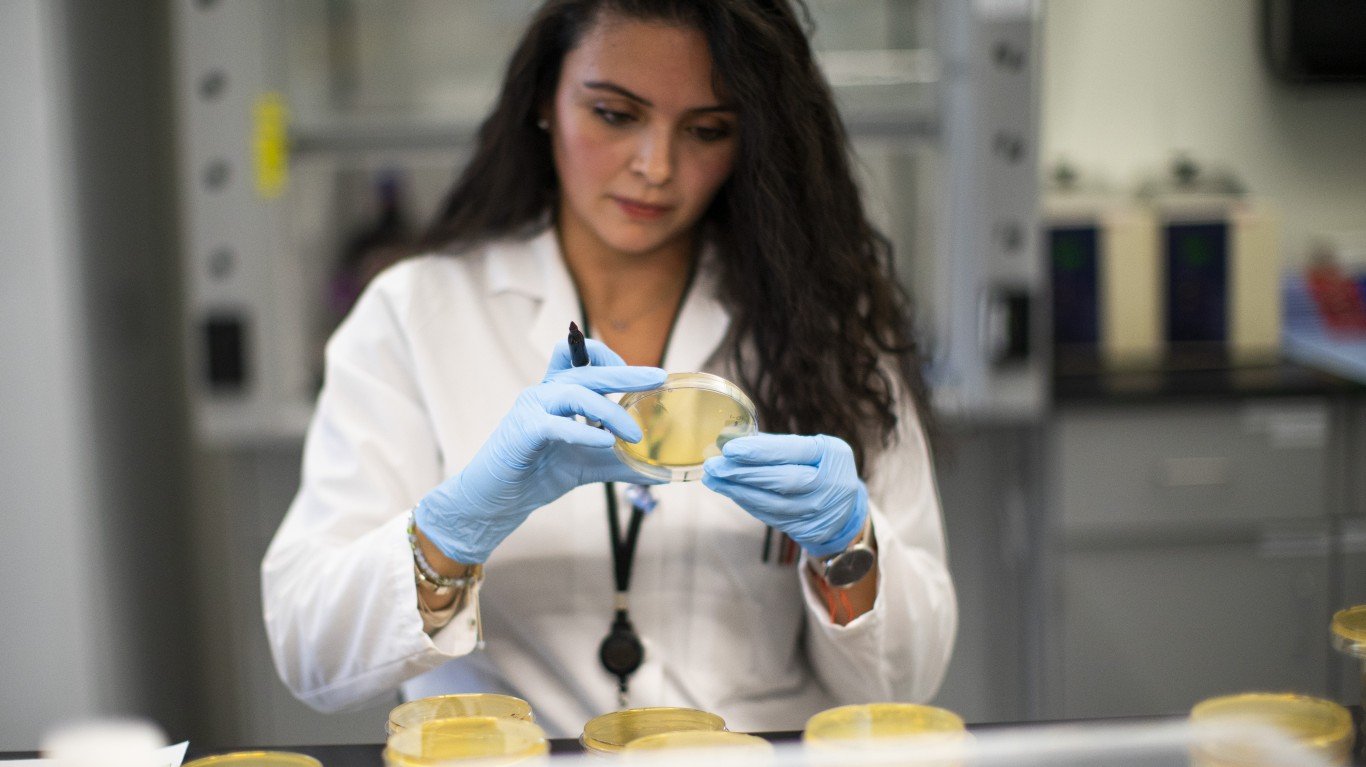
49. New Jersey
> Avg. daily tests as pct. of expert recommendation: 156.9%
> Avg. daily test rate from May 5 – May 11, 2020: 238.5 new tests per 100,000 people (21,245 tests per day)
> Positive test rate: 32.9% (the highest)
> COVID-19 infection rate as of May 11, 2020: 1,570.9 per 100,000 people — 2nd highest (139,945 total cases)
> COVID-19 death rate as of May 11, 2020: 104.5 per 100,000 people — 2nd highest (9,310 total deaths)
> Cumulative tests performed as of May 11, 2020: 425,933 (6th most)
> Date of first case: March 4, 2020
> Total population: 8.9 million (11th most)
48. North Dakota
> Avg. daily tests as pct. of expert recommendation: 151.6%
> Avg. daily test rate from May 5 – May 11, 2020: 230.4 new tests per 100,000 people (1,751 tests per day)
> Positive test rate: 3.2% (5th lowest)
> COVID-19 infection rate as of May 11, 2020: 199.7 per 100,000 people — 21st lowest (1,518 total cases)
> COVID-19 death rate as of May 11, 2020: 4.7 per 100,000 people — 13th lowest (36 total deaths)
> Cumulative tests performed as of May 11, 2020: 47,014 (11th fewest)
> Date of first case: March 11, 2020
> Total population: 760,077 (4th fewest)
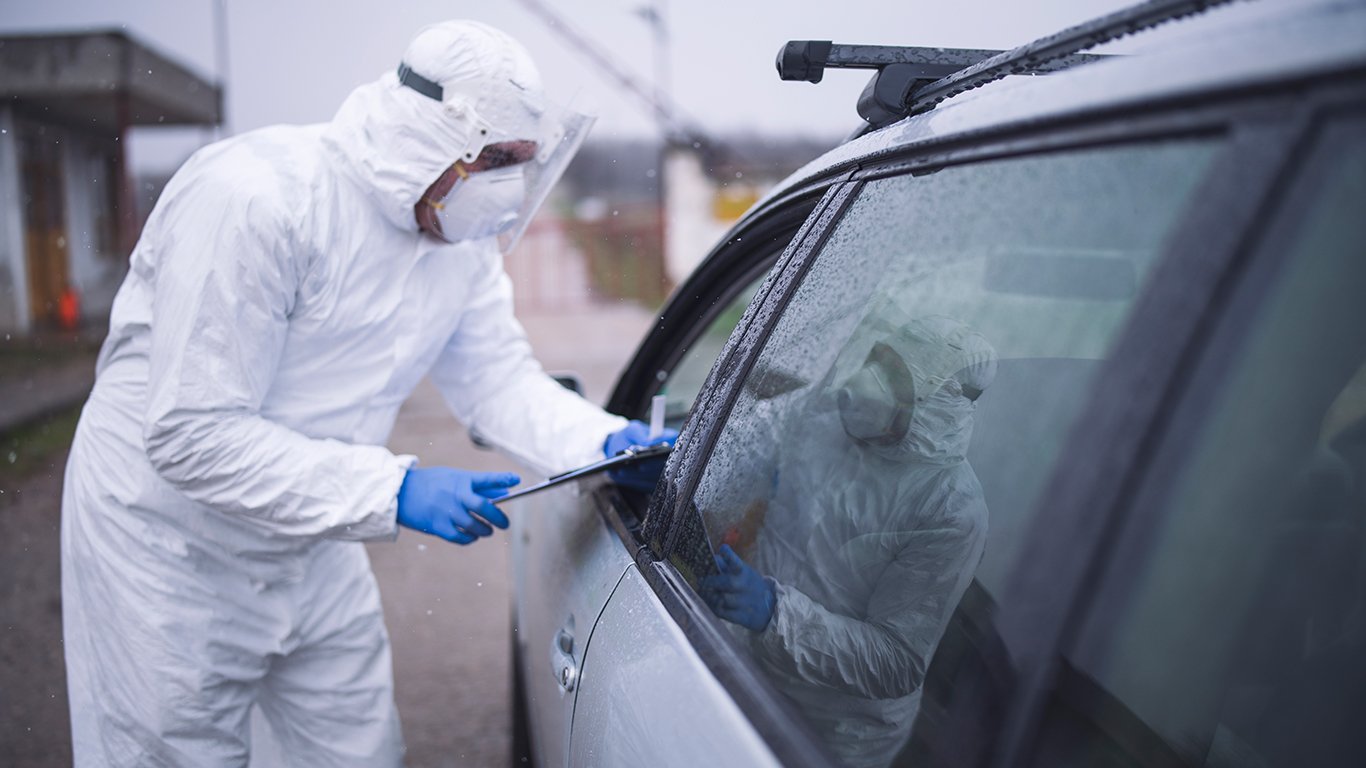
47. New Mexico
> Avg. daily tests as pct. of expert recommendation: 112.1%
> Avg. daily test rate from May 5 – May 11, 2020: 170.4 new tests per 100,000 people (3,572 tests per day)
> Positive test rate: 4.7% (10th lowest)
> COVID-19 infection rate as of May 11, 2020: 241.9 per 100,000 people — 21st highest (5,069 total cases)
> COVID-19 death rate as of May 11, 2020: 9.9 per 100,000 people — 20th highest (208 total deaths)
> Cumulative tests performed as of May 11, 2020: 106,721 (24th fewest)
> Date of first case: March 11, 2020
> Total population: 2.1 million (15th fewest)
[in-text-ad-2]
46. Massachusetts
> Avg. daily tests as pct. of expert recommendation: 95.9%
> Avg. daily test rate from May 5 – May 11, 2020: 145.8 new tests per 100,000 people (10,066 tests per day)
> Positive test rate: 19.9% (6th highest)
> COVID-19 infection rate as of May 11, 2020: 1,136.8 per 100,000 people — 3rd highest (78,462 total cases)
> COVID-19 death rate as of May 11, 2020: 74.0 per 100,000 people — 4th highest (5,108 total deaths)
> Cumulative tests performed as of May 11, 2020: 394,728 (7th most)
> Date of first case: February 1, 2020
> Total population: 6.9 million (15th most)
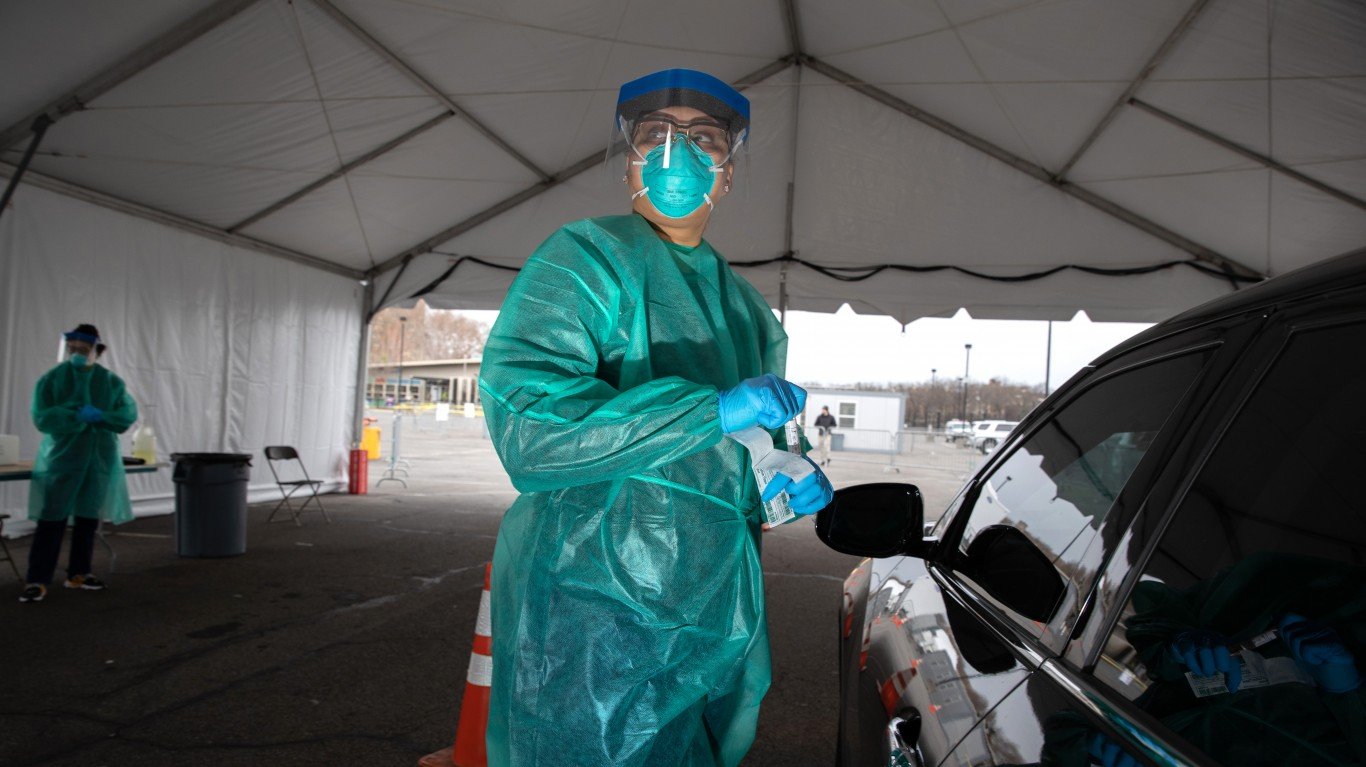
45. New York
> Avg. daily tests as pct. of expert recommendation: 94.9%
> Avg. daily test rate from May 5 – May 11, 2020: 144.3 new tests per 100,000 people (28,191 tests per day)
> Positive test rate: 28.0% (2nd highest)
> COVID-19 infection rate as of May 11, 2020: 1,724.8 per 100,000 people — the highest (337,055 total cases)
> COVID-19 death rate as of May 11, 2020: 110.7 per 100,000 people — the highest (21,640 total deaths)
> Cumulative tests performed as of May 11, 2020: 1.2 million (the most)
> Date of first case: March 1, 2020
> Total population: 19.5 million (4th most)
[in-text-ad]
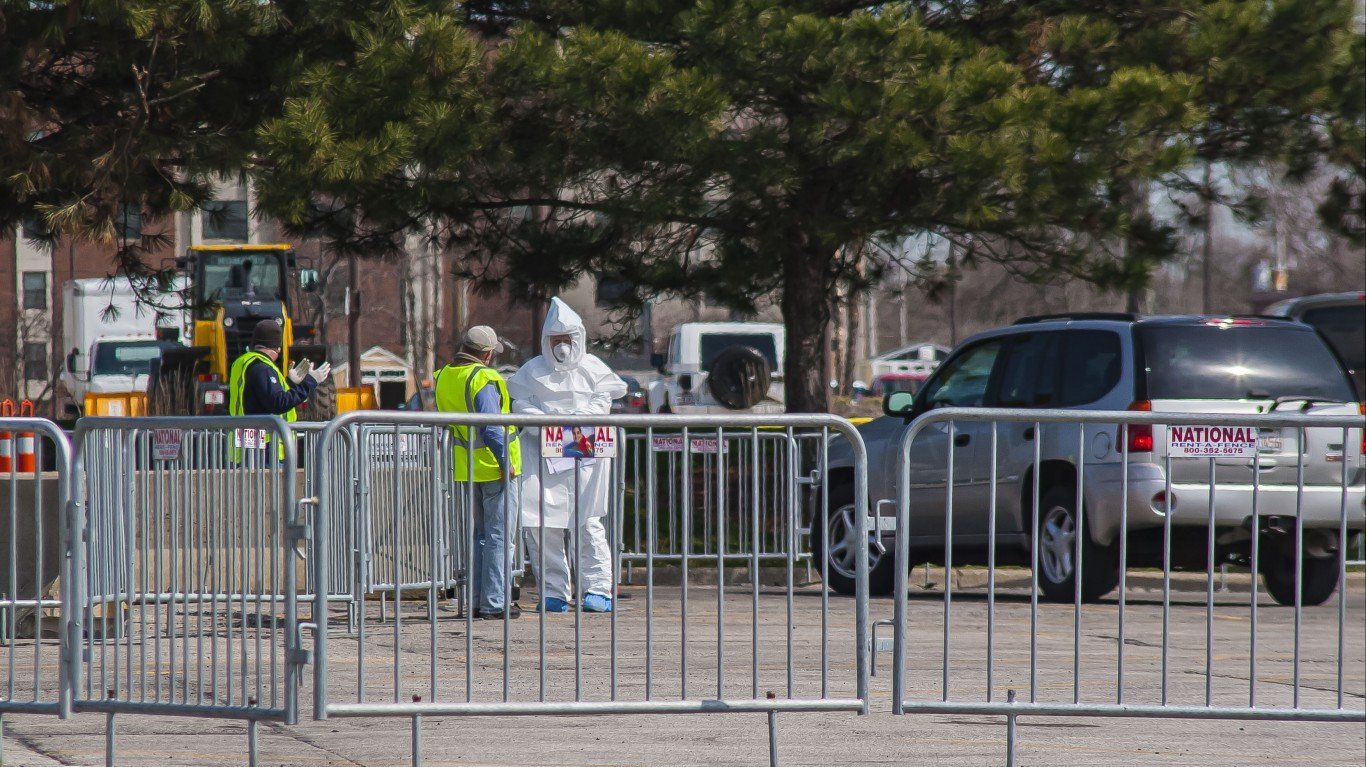
44. Illinois
> Avg. daily tests as pct. of expert recommendation: 90.8%
> Avg. daily test rate from May 5 – May 11, 2020: 138.0 new tests per 100,000 people (17,587 tests per day)
> Positive test rate: 17.9% (10th highest)
> COVID-19 infection rate as of May 11, 2020: 620.1 per 100,000 people — 8th highest (79,007 total cases)
> COVID-19 death rate as of May 11, 2020: 27.1 per 100,000 people — 9th highest (3,459 total deaths)
> Cumulative tests performed as of May 11, 2020: 442,425 (5th most)
> Date of first case: January 24, 2020
> Total population: 12.7 million (6th most)
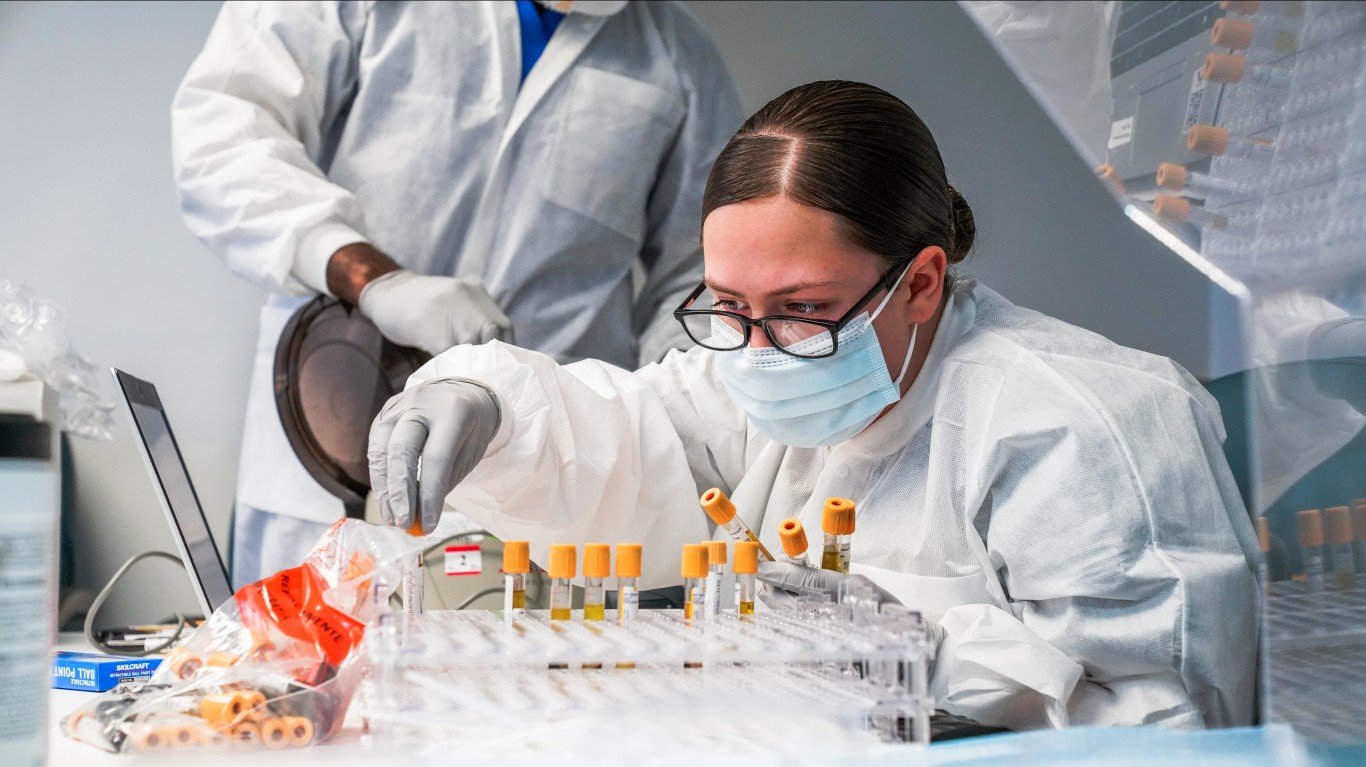
43. Alaska
> Avg. daily tests as pct. of expert recommendation: 88.7%
> Avg. daily test rate from May 5 – May 11, 2020: 134.8 new tests per 100,000 people (994 tests per day)
> Positive test rate: 1.3% (the lowest)
> COVID-19 infection rate as of May 11, 2020: 51.7 per 100,000 people — 3rd lowest (381 total cases)
> COVID-19 death rate as of May 11, 2020: 1.4 per 100,000 people — 3rd lowest (10 total deaths)
> Cumulative tests performed as of May 11, 2020: 28,680 (6th fewest)
> Date of first case: March 12, 2020
> Total population: 737,438 (3rd fewest)
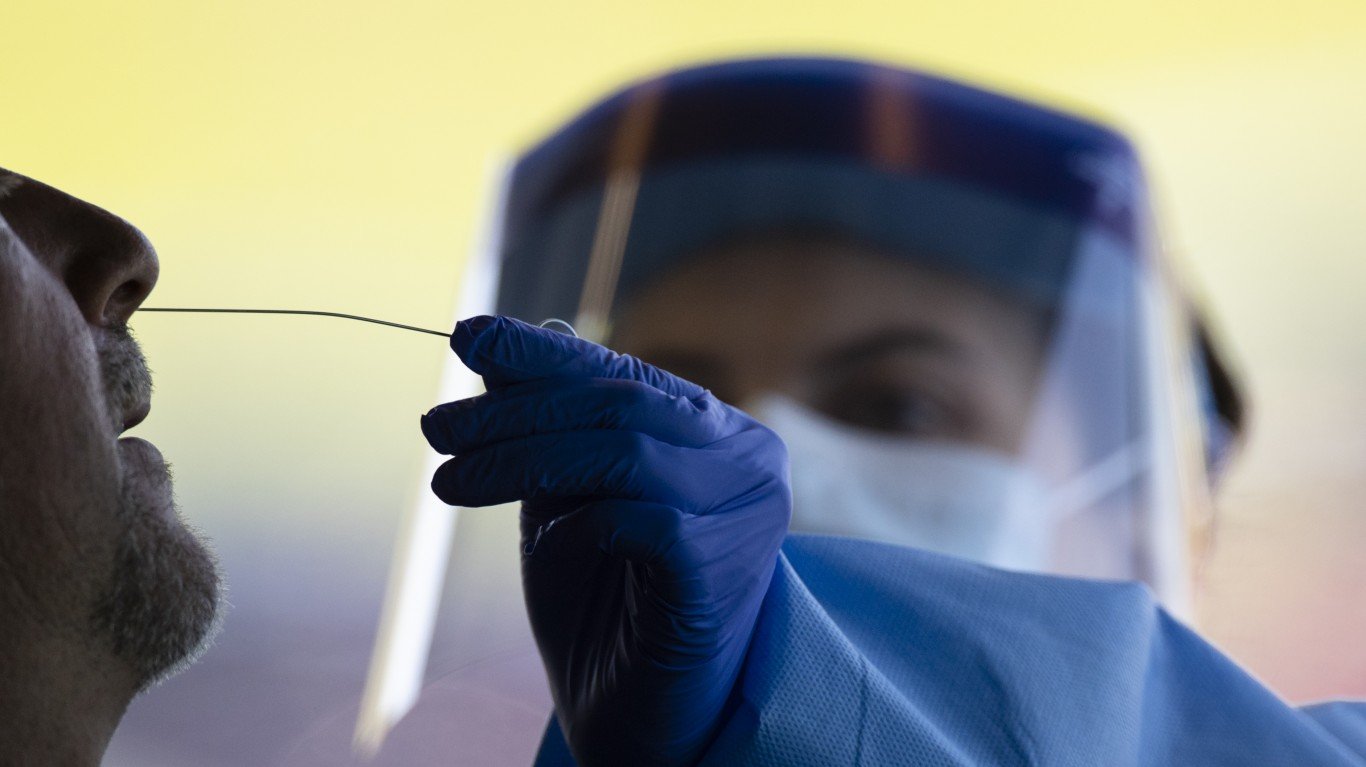
42. Tennessee
> Avg. daily tests as pct. of expert recommendation: 85.8%
> Avg. daily test rate from May 5 – May 11, 2020: 130.5 new tests per 100,000 people (8,833 tests per day)
> Positive test rate: 5.7% (12th lowest)
> COVID-19 infection rate as of May 11, 2020: 229.6 per 100,000 people — 23rd highest (15,544 total cases)
> COVID-19 death rate as of May 11, 2020: 3.7 per 100,000 people — 9th lowest (251 total deaths)
> Cumulative tests performed as of May 11, 2020: 273,277 (10th most)
> Date of first case: March 5, 2020
> Total population: 6.8 million (16th most)
[in-text-ad-2]
41. Arizona
> Avg. daily tests as pct. of expert recommendation: 81.2%
> Avg. daily test rate from May 5 – May 11, 2020: 123.5 new tests per 100,000 people (8,854 tests per day)
> Positive test rate: 7.6% (19th lowest)
> COVID-19 infection rate as of May 11, 2020: 158.7 per 100,000 people — 16th lowest (11,380 total cases)
> COVID-19 death rate as of May 11, 2020: 7.6 per 100,000 people — 23rd lowest (542 total deaths)
> Cumulative tests performed as of May 11, 2020: 150,241 (19th most)
> Date of first case: January 26, 2020
> Total population: 7.2 million (14th most)
40. Louisiana
> Avg. daily tests as pct. of expert recommendation: 80.5%
> Avg. daily test rate from May 5 – May 11, 2020: 122.3 new tests per 100,000 people (5,700 tests per day)
> Positive test rate: 14.4% (16th highest)
> COVID-19 infection rate as of May 11, 2020: 682.7 per 100,000 people — 6th highest (31,815 total cases)
> COVID-19 death rate as of May 11, 2020: 48.1 per 100,000 people — 5th highest (2,242 total deaths)
> Cumulative tests performed as of May 11, 2020: 220,830 (13th most)
> Date of first case: March 9, 2020
> Total population: 4.7 million (25th most)
[in-text-ad]
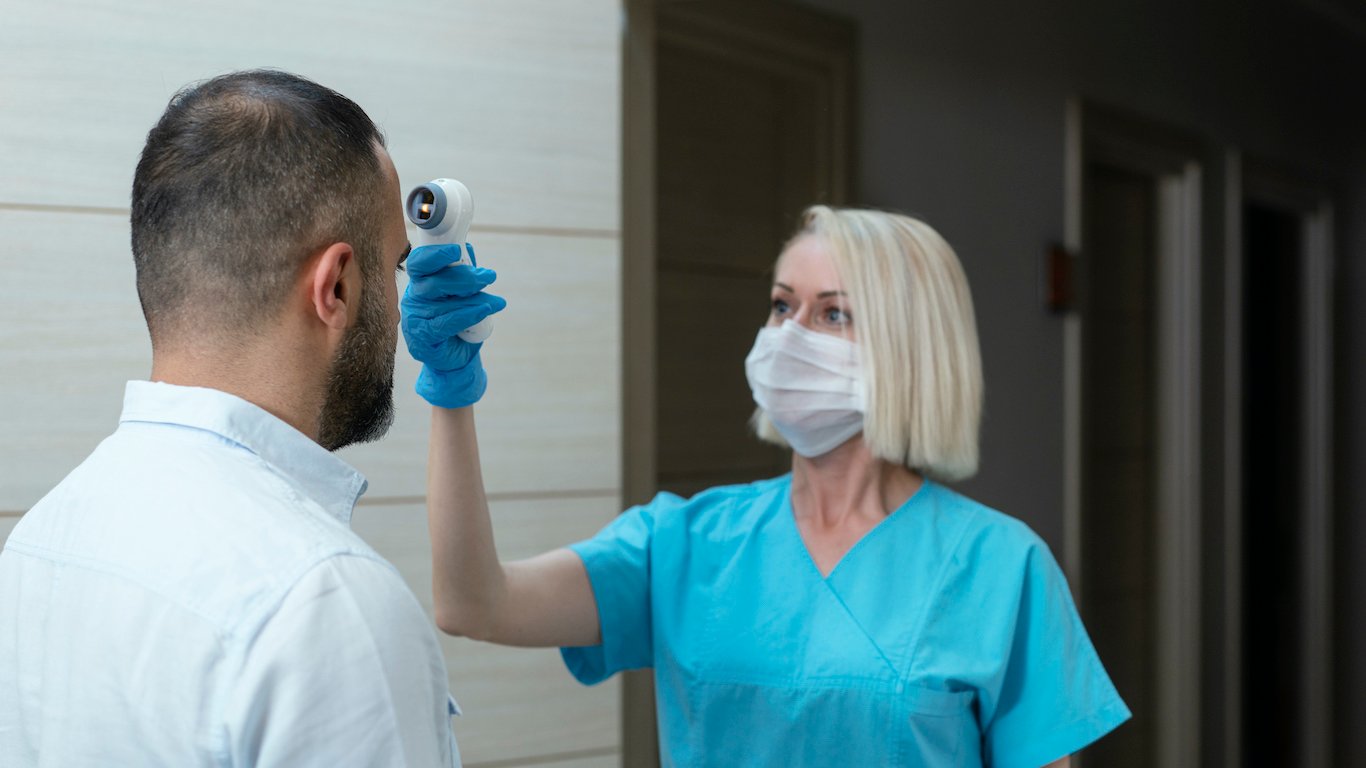
39. Utah
> Avg. daily tests as pct. of expert recommendation: 77.1%
> Avg. daily test rate from May 5 – May 11, 2020: 117.2 new tests per 100,000 people (3,703 tests per day)
> Positive test rate: 4.2% (8th lowest)
> COVID-19 infection rate as of May 11, 2020: 201.3 per 100,000 people — 22nd lowest (6,362 total cases)
> COVID-19 death rate as of May 11, 2020: 2.2 per 100,000 people — 5th lowest (68 total deaths)
> Cumulative tests performed as of May 11, 2020: 150,585 (18th most)
> Date of first case: February 25, 2020
> Total population: 3.2 million (21st fewest)
38. Oklahoma
> Avg. daily tests as pct. of expert recommendation: 76.6%
> Avg. daily test rate from May 5 – May 11, 2020: 116.5 new tests per 100,000 people (4,592 tests per day)
> Positive test rate: 4.8% (11th lowest)
> COVID-19 infection rate as of May 11, 2020: 117.0 per 100,000 people — 9th lowest (4,613 total cases)
> COVID-19 death rate as of May 11, 2020: 6.9 per 100,000 people — 20th lowest (274 total deaths)
> Cumulative tests performed as of May 11, 2020: 95,992 (23rd fewest)
> Date of first case: March 6, 2020
> Total population: 3.9 million (23rd fewest)
37. Delaware
> Avg. daily tests as pct. of expert recommendation: 76.0%
> Avg. daily test rate from May 5 – May 11, 2020: 115.5 new tests per 100,000 people (1,117 tests per day)
> Positive test rate: 20.6% (4th highest)
> COVID-19 infection rate as of May 11, 2020: 678.8 per 100,000 people — 7th highest (6,565 total cases)
> COVID-19 death rate as of May 11, 2020: 23.3 per 100,000 people — 11th highest (225 total deaths)
> Cumulative tests performed as of May 11, 2020: 31,928 (7th fewest)
> Date of first case: March 11, 2020
> Total population: 967,171 (6th fewest)
[in-text-ad-2]
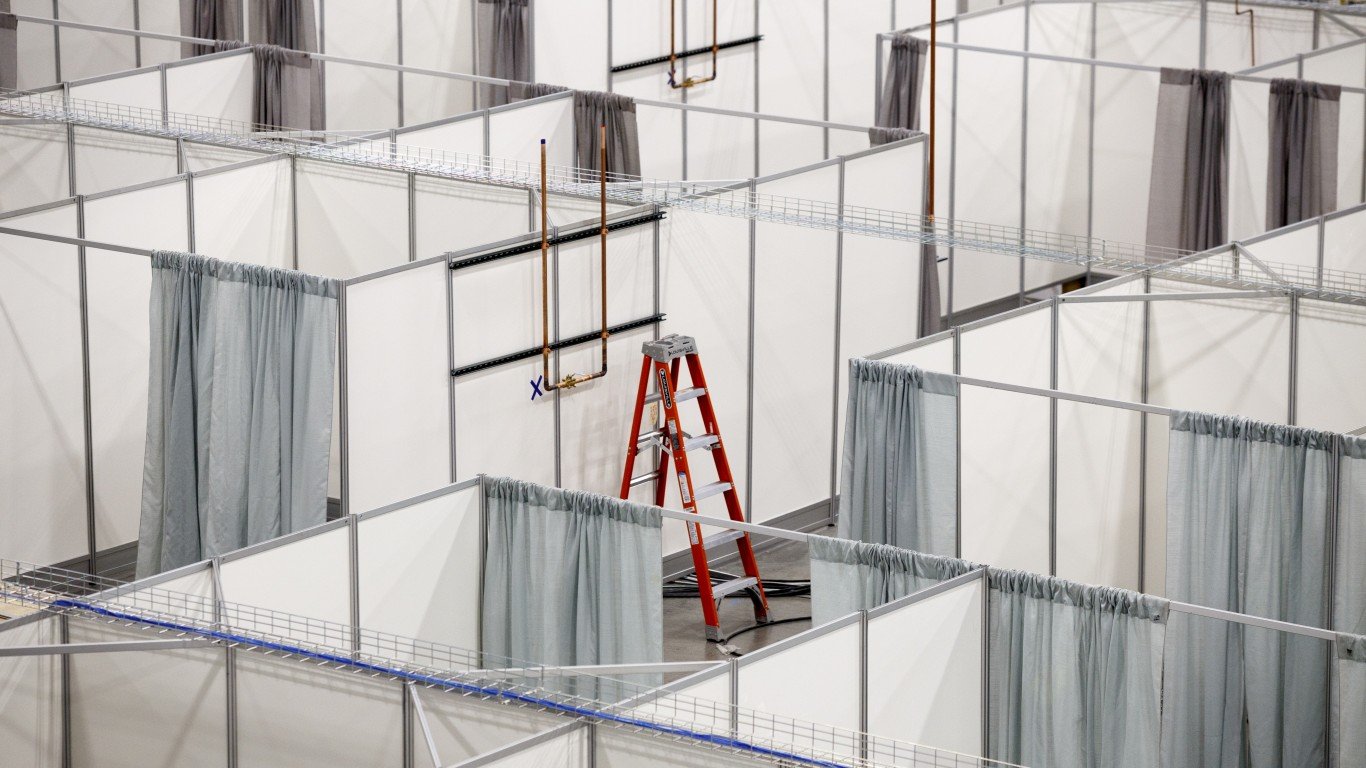
36. Michigan
> Avg. daily tests as pct. of expert recommendation: 72.0%
> Avg. daily test rate from May 5 – May 11, 2020: 109.4 new tests per 100,000 people (10,937 tests per day)
> Positive test rate: 15.9% (12th highest)
> COVID-19 infection rate as of May 11, 2020: 475.7 per 100,000 people — 10th highest (47,552 total cases)
> COVID-19 death rate as of May 11, 2020: 45.9 per 100,000 people — 6th highest (4,584 total deaths)
> Cumulative tests performed as of May 11, 2020: 298,948 (8th most)
> Date of first case: March 10, 2020
> Total population: 10.0 million (10th most)
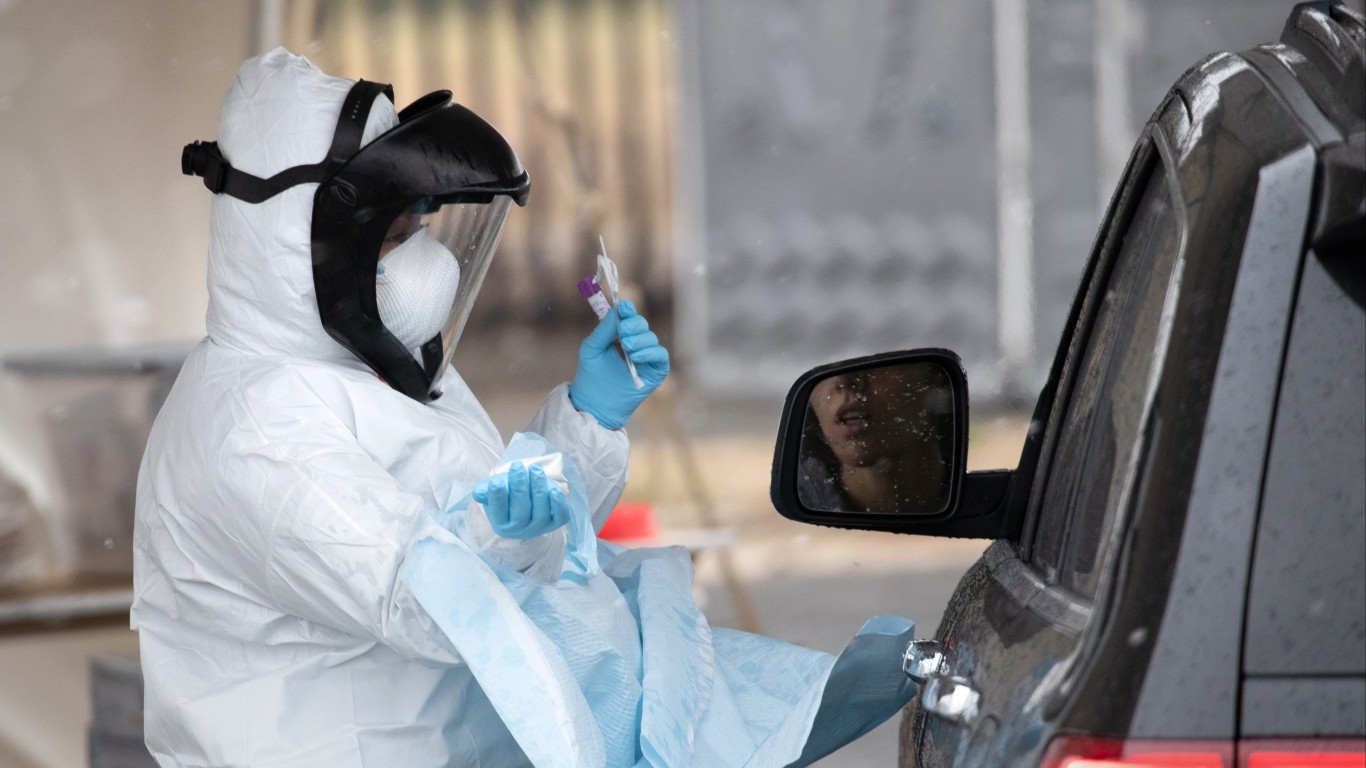
35. Connecticut
> Avg. daily tests as pct. of expert recommendation: 71.5%
> Avg. daily test rate from May 5 – May 11, 2020: 108.7 new tests per 100,000 people (3,883 tests per day)
> Positive test rate: 25.5% (3rd highest)
> COVID-19 infection rate as of May 11, 2020: 945.1 per 100,000 people — 5th highest (33,765 total cases)
> COVID-19 death rate as of May 11, 2020: 84.2 per 100,000 people — 3rd highest (3,008 total deaths)
> Cumulative tests performed as of May 11, 2020: 132,508 (21st most)
> Date of first case: March 8, 2020
> Total population: 3.6 million (22nd fewest)
[in-text-ad]
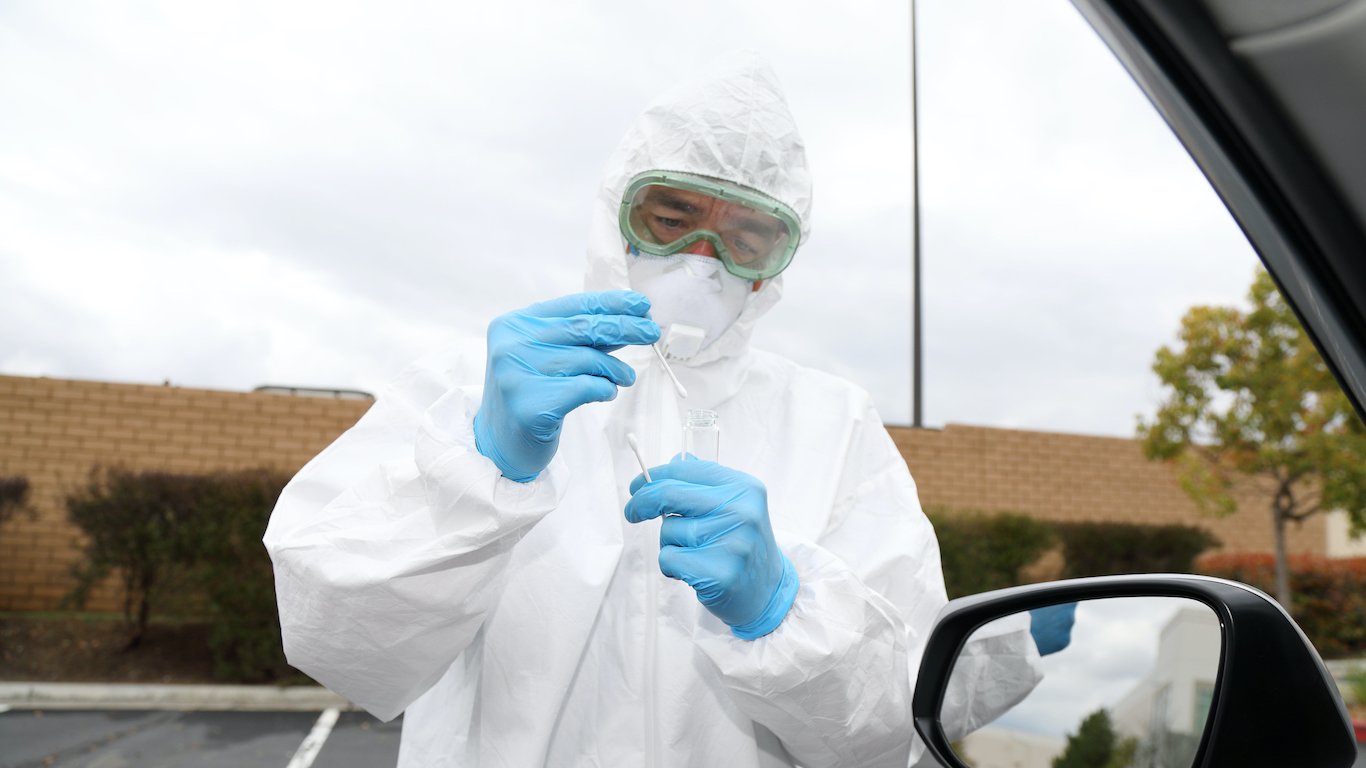
34. Wyoming
> Avg. daily tests as pct. of expert recommendation: 66.6%
> Avg. daily test rate from May 5 – May 11, 2020: 101.2 new tests per 100,000 people (585 tests per day)
> Positive test rate: 3.5% (6th lowest)
> COVID-19 infection rate as of May 11, 2020: 87.2 per 100,000 people — 6th lowest (504 total cases)
> COVID-19 death rate as of May 11, 2020: 1.2 per 100,000 people — 2nd lowest (7 total deaths)
> Cumulative tests performed as of May 11, 2020: 14,546 (the fewest)
> Date of first case: March 11, 2020
> Total population: 577,737 (the fewest)
33. Montana
> Avg. daily tests as pct. of expert recommendation: 66.2%
> Avg. daily test rate from May 5 – May 11, 2020: 100.6 new tests per 100,000 people (1,069 tests per day)
> Positive test rate: 2.0% (3rd lowest)
> COVID-19 infection rate as of May 11, 2020: 43.2 per 100,000 people — the lowest (459 total cases)
> COVID-19 death rate as of May 11, 2020: 1.5 per 100,000 people — 4th lowest (16 total deaths)
> Cumulative tests performed as of May 11, 2020: 22,572 (3rd fewest)
> Date of first case: March 1March 2020
> Total population: 1.1 million (8th fewest)
32. Nebraska
> Avg. daily tests as pct. of expert recommendation: 65.0%
> Avg. daily test rate from May 5 – May 11, 2020: 98.8 new tests per 100,000 people (1,906 tests per day)
> Positive test rate: 18.0% (9th highest)
> COVID-19 infection rate as of May 11, 2020: 444.3 per 100,000 people — 12th highest (8,572 total cases)
> COVID-19 death rate as of May 11, 2020: 5.2 per 100,000 people — 15th lowest (100 total deaths)
> Cumulative tests performed as of May 11, 2020: 48,019 (12th fewest)
> Date of first case: February 17, 2020
> Total population: 1.9 million (14th fewest)
[in-text-ad-2]

31. South Dakota
> Avg. daily tests as pct. of expert recommendation: 62.5%
> Avg. daily test rate from May 5 – May 11, 2020: 95.0 new tests per 100,000 people (838 tests per day)
> Positive test rate: 14.7% (15th highest)
> COVID-19 infection rate as of May 11, 2020: 409.6 per 100,000 people — 13th highest (3,614 total cases)
> COVID-19 death rate as of May 11, 2020: 3.9 per 100,000 people — 12th lowest (34 total deaths)
> Cumulative tests performed as of May 11, 2020: 24,578 (5th fewest)
> Date of first case: March 10, 2020
> Total population: 882,235 (5th fewest)
30. Iowa
> Avg. daily tests as pct. of expert recommendation: 61.4%
> Avg. daily test rate from May 5 – May 11, 2020: 93.4 new tests per 100,000 people (2,947 tests per day)
> Positive test rate: 15.9% (13th highest)
> COVID-19 infection rate as of May 11, 2020: 392.0 per 100,000 people — 14th highest (12,373 total cases)
> COVID-19 death rate as of May 11, 2020: 8.6 per 100,000 people — 23rd highest (271 total deaths)
> Cumulative tests performed as of May 11, 2020: 77,792 (18th fewest)
> Date of first case: March 8, 2020
> Total population: 3.2 million (20th fewest)
[in-text-ad]
29. Georgia
> Avg. daily tests as pct. of expert recommendation: 61.0%
> Avg. daily test rate from May 5 – May 11, 2020: 92.7 new tests per 100,000 people (9,754 tests per day)
> Positive test rate: 13.6% (17th highest)
> COVID-19 infection rate as of May 11, 2020: 324.8 per 100,000 people — 17th highest (34,165 total cases)
> COVID-19 death rate as of May 11, 2020: 13.9 per 100,000 people — 15th highest (1,460 total deaths)
> Cumulative tests performed as of May 11, 2020: 251,290 (11th most)
> Date of first case: March 2, 2020
> Total population: 10.5 million (8th most)
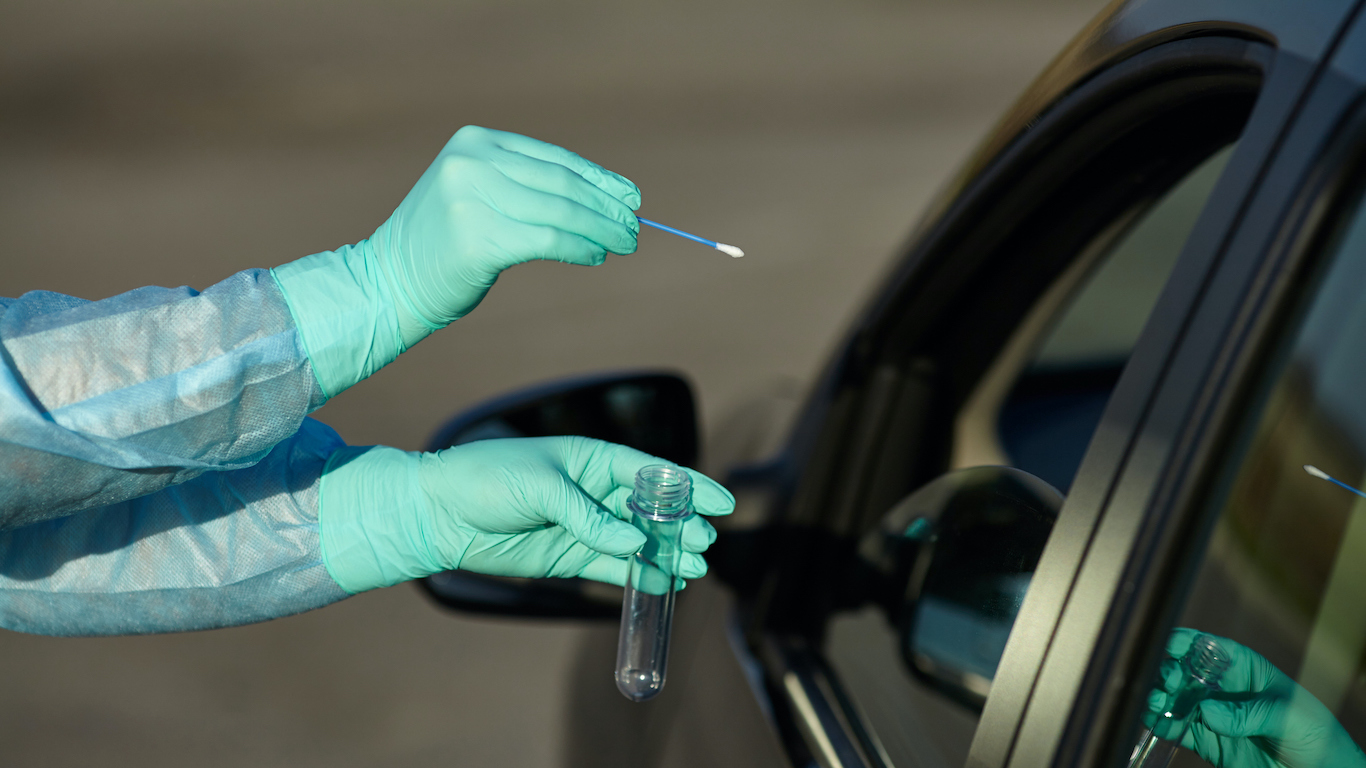
28. New Hampshire
> Avg. daily tests as pct. of expert recommendation: 60.2%
> Avg. daily test rate from May 5 – May 11, 2020: 91.5 new tests per 100,000 people (1,242 tests per day)
> Positive test rate: 8.9% (24th highest)
> COVID-19 infection rate as of May 11, 2020: 233.0 per 100,000 people — 22nd highest (3,160 total cases)
> COVID-19 death rate as of May 11, 2020: 9.8 per 100,000 people — 21st highest (133 total deaths)
> Cumulative tests performed as of May 11, 2020: 35,561 (9th fewest)
> Date of first case: March 2, 2020
> Total population: 1.4 million (10th fewest)
27. Kentucky
> Avg. daily tests as pct. of expert recommendation: 60.0%
> Avg. daily test rate from May 5 – May 11, 2020: 91.2 new tests per 100,000 people (4,073 tests per day)
> Positive test rate: 7.7% (22nd lowest)
> COVID-19 infection rate as of May 11, 2020: 149.4 per 100,000 people — 14th lowest (6,677 total cases)
> COVID-19 death rate as of May 11, 2020: 7.0 per 100,000 people — 21st lowest (311 total deaths)
> Cumulative tests performed as of May 11, 2020: 86,923 (19th fewest)
> Date of first case: March 6, 2020
> Total population: 4.5 million (25th fewest)
[in-text-ad-2]
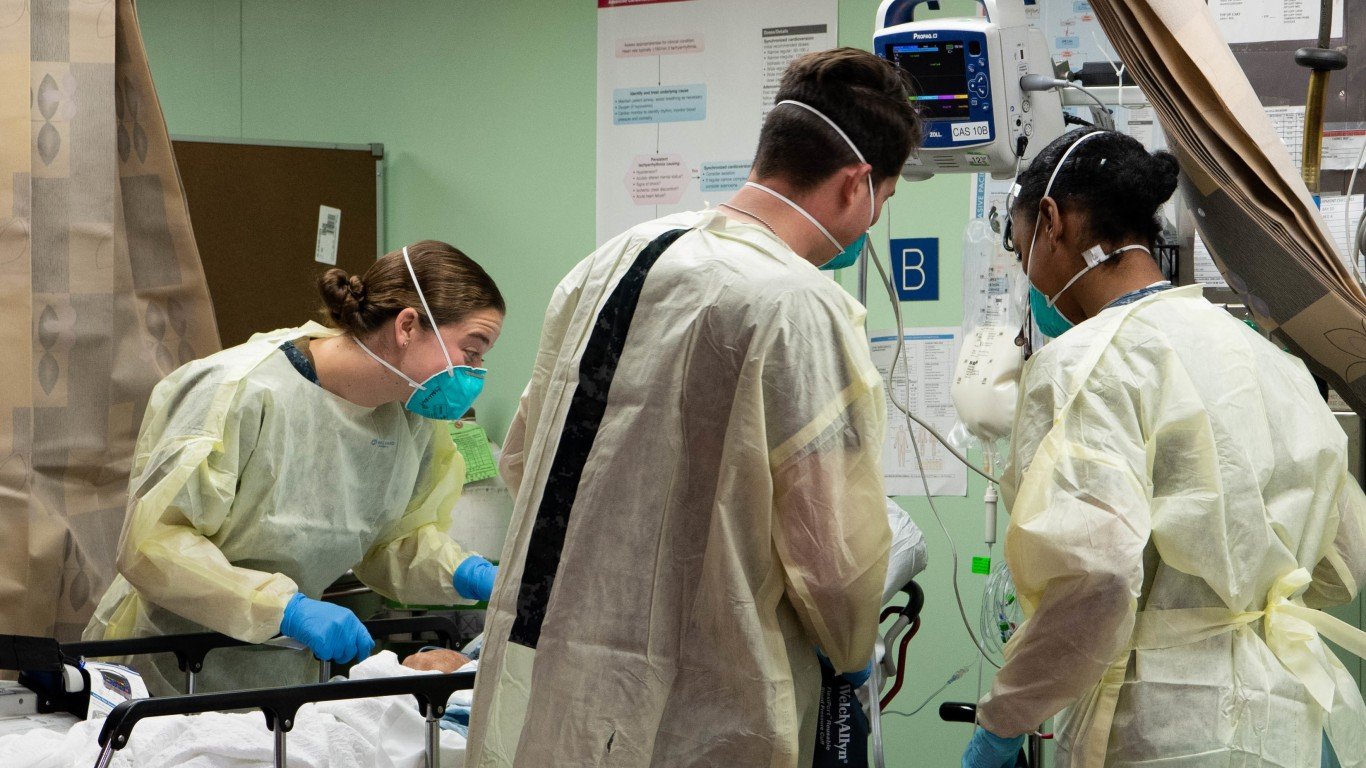
26. California
> Avg. daily tests as pct. of expert recommendation: 58.0%
> Avg. daily test rate from May 5 – May 11, 2020: 88.1 new tests per 100,000 people (34,860 tests per day)
> Positive test rate: 6.9% (16th lowest)
> COVID-19 infection rate as of May 11, 2020: 171.9 per 100,000 people — 18th lowest (67,986 total cases)
> COVID-19 death rate as of May 11, 2020: 6.9 per 100,000 people — 19th lowest (2,719 total deaths)
> Cumulative tests performed as of May 11, 2020: 991,897 (2nd most)
> Date of first case: January 25, 2020
> Total population: 39.6 million (the most)

25. Vermont
> Avg. daily tests as pct. of expert recommendation: 53.1%
> Avg. daily test rate from May 5 – May 11, 2020: 80.7 new tests per 100,000 people (506 tests per day)
> Positive test rate: 4.4% (9th lowest)
> COVID-19 infection rate as of May 11, 2020: 147.9 per 100,000 people — 13th lowest (926 total cases)
> COVID-19 death rate as of May 11, 2020: 8.5 per 100,000 people — 24th highest (53 total deaths)
> Cumulative tests performed as of May 11, 2020: 20,871 (2nd fewest)
> Date of first case: March 7, 2020
> Total population: 626,299 (2nd fewest)
[in-text-ad]
24. West Virginia
> Avg. daily tests as pct. of expert recommendation: 52.5%
> Avg. daily test rate from May 5 – May 11, 2020: 79.8 new tests per 100,000 people (1,441 tests per day)
> Positive test rate: 2.1% (4th lowest)
> COVID-19 infection rate as of May 11, 2020: 75.8 per 100,000 people — 4th lowest (1,369 total cases)
> COVID-19 death rate as of May 11, 2020: 3.2 per 100,000 people — 8th lowest (57 total deaths)
> Cumulative tests performed as of May 11, 2020: 64,165 (15th fewest)
> Date of first case: March 17, 2020
> Total population: 1.8 million (13th fewest)
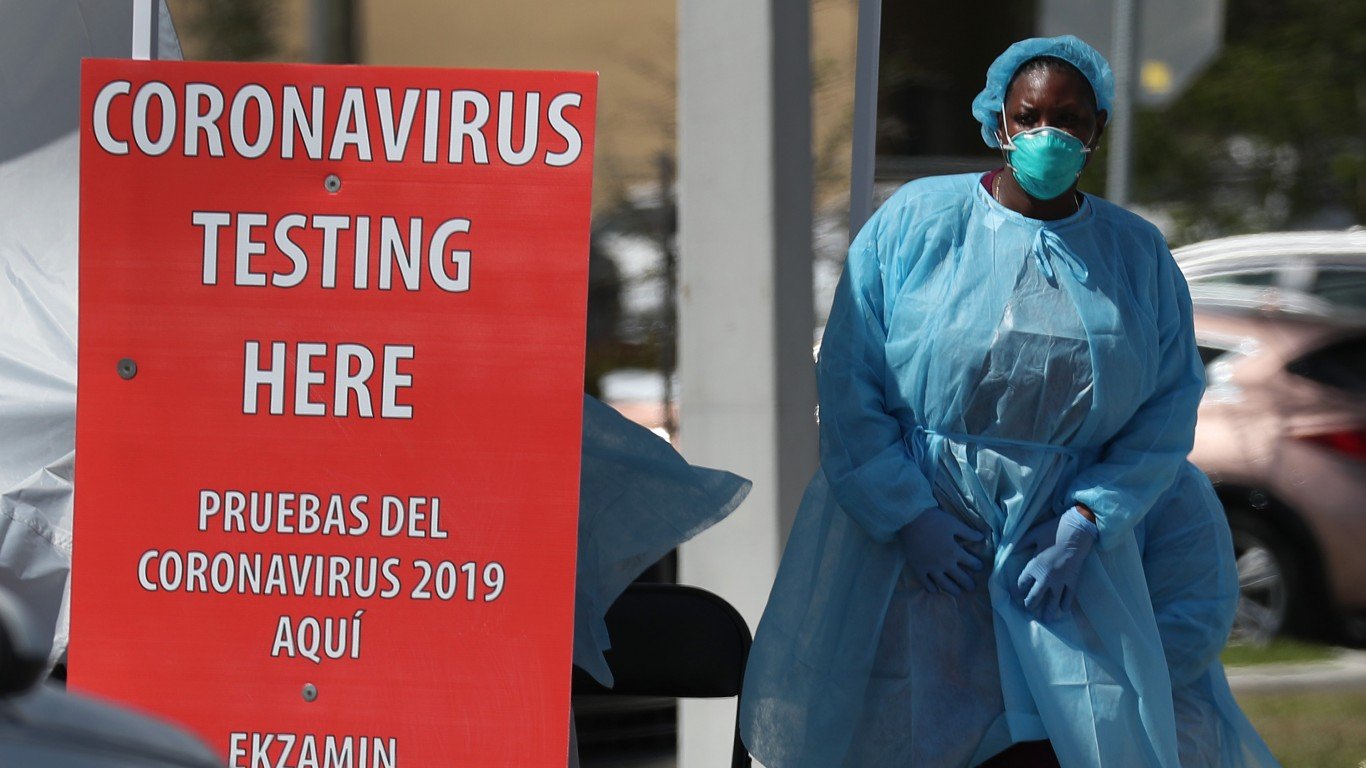
23. Florida
> Avg. daily tests as pct. of expert recommendation: 51.1%
> Avg. daily test rate from May 5 – May 11, 2020: 77.6 new tests per 100,000 people (16,535 tests per day)
> Positive test rate: 7.4% (18th lowest)
> COVID-19 infection rate as of May 11, 2020: 192.4 per 100,000 people — 20th lowest (40,982 total cases)
> COVID-19 death rate as of May 11, 2020: 8.1 per 100,000 people — 25th lowest (1,735 total deaths)
> Cumulative tests performed as of May 11, 2020: 561,741 (3rd most)
> Date of first case: March 1, 2020
> Total population: 21.3 million (3rd most)
22. Mississippi
> Avg. daily tests as pct. of expert recommendation: 51.0%
> Avg. daily test rate from May 5 – May 11, 2020: 77.5 new tests per 100,000 people (2,315 tests per day)
> Positive test rate: 10.1% (23rd highest)
> COVID-19 infection rate as of May 11, 2020: 323.9 per 100,000 people — 18th highest (9,674 total cases)
> COVID-19 death rate as of May 11, 2020: 14.6 per 100,000 people — 14th highest (435 total deaths)
> Cumulative tests performed as of May 11, 2020: 95,885 (22nd fewest)
> Date of first case: March 11, 2020
> Total population: 3.0 million (17th fewest)
[in-text-ad-2]
21. Alabama
> Avg. daily tests as pct. of expert recommendation: 50.3%
> Avg. daily test rate from May 5 – May 11, 2020: 76.4 new tests per 100,000 people (3,735 tests per day)
> Positive test rate: 7.9% (23rd lowest)
> COVID-19 infection rate as of May 11, 2020: 207.9 per 100,000 people — 24th lowest (10,164 total cases)
> COVID-19 death rate as of May 11, 2020: 8.2 per 100,000 people — 25th highest (403 total deaths)
> Cumulative tests performed as of May 11, 2020: 129,444 (22nd most)
> Date of first case: March 1March 2020
> Total population: 4.9 million (24th most)
20. Minnesota
> Avg. daily tests as pct. of expert recommendation: 50.0%
> Avg. daily test rate from May 5 – May 11, 2020: 76.0 new tests per 100,000 people (4,263 tests per day)
> Positive test rate: 10.2% (22nd highest)
> COVID-19 infection rate as of May 11, 2020: 210.3 per 100,000 people — 25th lowest (11,799 total cases)
> COVID-19 death rate as of May 11, 2020: 10.5 per 100,000 people — 18th highest (591 total deaths)
> Cumulative tests performed as of May 11, 2020: 115,781 (25th most)
> Date of first case: March 6, 2020
> Total population: 5.6 million (22nd most)
[in-text-ad]
19. Kansas
> Avg. daily tests as pct. of expert recommendation: 49.7%
> Avg. daily test rate from May 5 – May 11, 2020: 75.5 new tests per 100,000 people (2,198 tests per day)
> Positive test rate: 13.2% (18th highest)
> COVID-19 infection rate as of May 11, 2020: 244.4 per 100,000 people — 20th highest (7,116 total cases)
> COVID-19 death rate as of May 11, 2020: 5.4 per 100,000 people — 17th lowest (158 total deaths)
> Cumulative tests performed as of May 11, 2020: 54,109 (13th fewest)
> Date of first case: March 7, 2020
> Total population: 2.9 million (16th fewest)
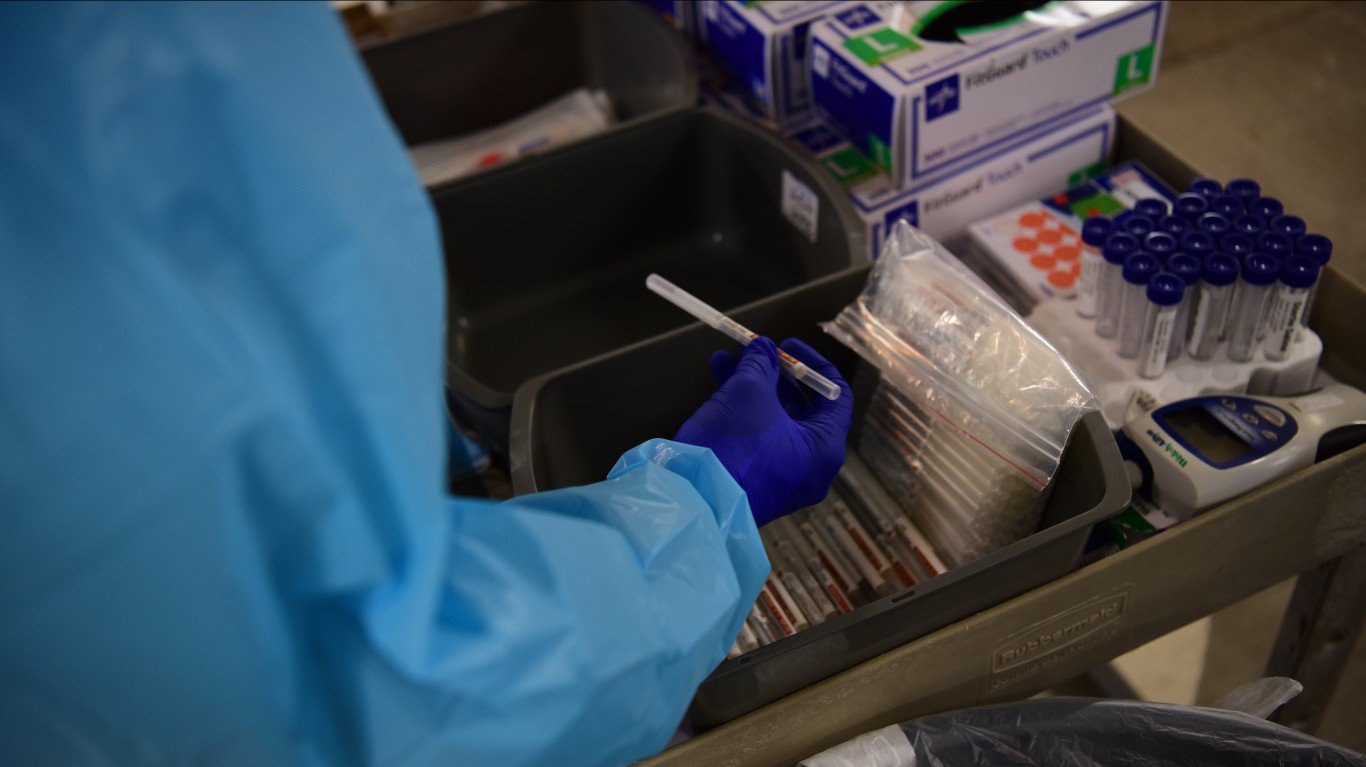
18. Arkansas
> Avg. daily tests as pct. of expert recommendation: 49.5%
> Avg. daily test rate from May 5 – May 11, 2020: 75.3 new tests per 100,000 people (2,269 tests per day)
> Positive test rate: 5.7% (13th lowest)
> COVID-19 infection rate as of May 11, 2020: 134.1 per 100,000 people — 10th lowest (4,043 total cases)
> COVID-19 death rate as of May 11, 2020: 3.1 per 100,000 people — 7th lowest (94 total deaths)
> Cumulative tests performed as of May 11, 2020: 70,323 (16th fewest)
> Date of first case: March 11, 2020
> Total population: 3.0 million (18th fewest)
17. Wisconsin
> Avg. daily tests as pct. of expert recommendation: 48.1%
> Avg. daily test rate from May 5 – May 11, 2020: 73.1 new tests per 100,000 people (4,250 tests per day)
> Positive test rate: 8.8% (25th highest)
> COVID-19 infection rate as of May 11, 2020: 179.2 per 100,000 people — 19th lowest (10,418 total cases)
> COVID-19 death rate as of May 11, 2020: 7.0 per 100,000 people — 22nd lowest (409 total deaths)
> Cumulative tests performed as of May 11, 2020: 118,451 (24th most)
> Date of first case: February 5, 2020
> Total population: 5.8 million (20th most)
[in-text-ad-2]
16. Indiana
> Avg. daily tests as pct. of expert recommendation: 46.9%
> Avg. daily test rate from May 5 – May 11, 2020: 71.3 new tests per 100,000 people (4,770 tests per day)
> Positive test rate: 16.8% (11th highest)
> COVID-19 infection rate as of May 11, 2020: 368.0 per 100,000 people — 15th highest (24,627 total cases)
> COVID-19 death rate as of May 11, 2020: 21.1 per 100,000 people — 12th highest (1,411 total deaths)
> Cumulative tests performed as of May 11, 2020: 146,688 (20th most)
> Date of first case: March 6, 2020
> Total population: 6.7 million (17th most)
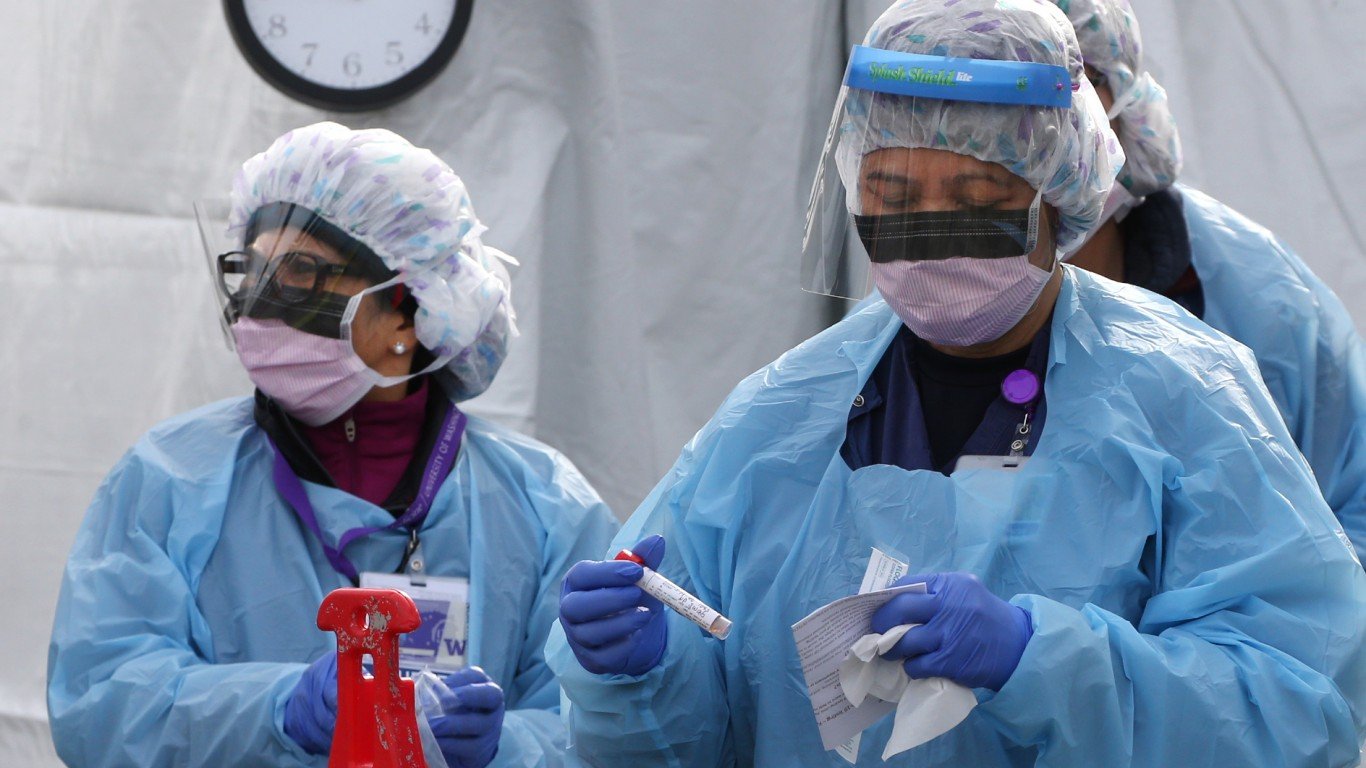
15. Washington
> Avg. daily tests as pct. of expert recommendation: 46.0%
> Avg. daily test rate from May 5 – May 11, 2020: 69.9 new tests per 100,000 people (5,267 tests per day)
> Positive test rate: 6.8% (15th lowest)
> COVID-19 infection rate as of May 11, 2020: 224.1 per 100,000 people — 24th highest (16,891 total cases)
> COVID-19 death rate as of May 11, 2020: 12.4 per 100,000 people — 16th highest (931 total deaths)
> Cumulative tests performed as of May 11, 2020: 248,875 (12th most)
> Date of first case: January 21, 2020
> Total population: 7.5 million (13th most)
[in-text-ad]
14. North Carolina
> Avg. daily tests as pct. of expert recommendation: 44.7%
> Avg. daily test rate from May 5 – May 11, 2020: 68.0 new tests per 100,000 people (7,061 tests per day)
> Positive test rate: 7.7% (21st lowest)
> COVID-19 infection rate as of May 11, 2020: 144.9 per 100,000 people — 12th lowest (15,045 total cases)
> COVID-19 death rate as of May 11, 2020: 5.3 per 100,000 people — 16th lowest (550 total deaths)
> Cumulative tests performed as of May 11, 2020: 195,865 (15th most)
> Date of first case: March March 2020
> Total population: 10.4 million (9th most)
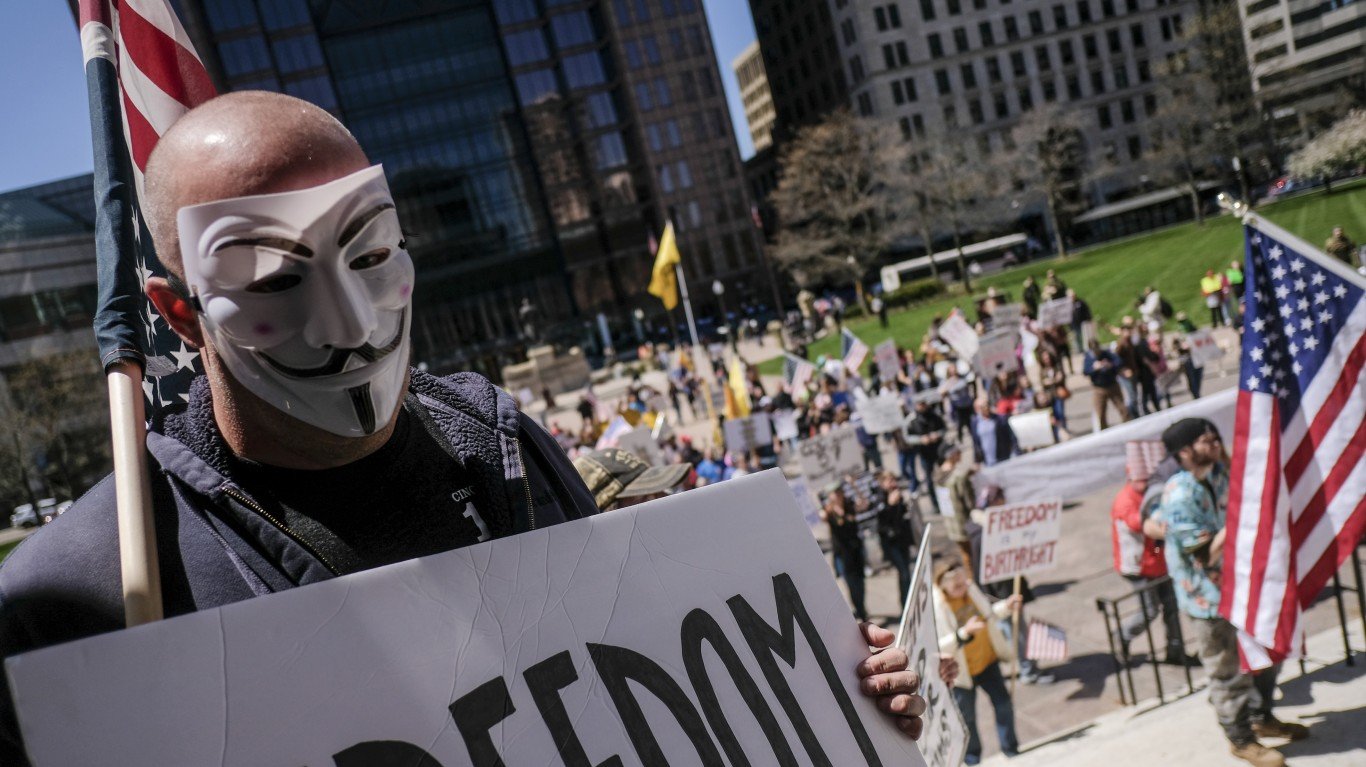
13. Ohio
> Avg. daily tests as pct. of expert recommendation: 44.5%
> Avg. daily test rate from May 5 – May 11, 2020: 67.7 new tests per 100,000 people (7,911 tests per day)
> Positive test rate: 11.8% (20th highest)
> COVID-19 infection rate as of May 11, 2020: 212.0 per 100,000 people — 25th highest (24,777 total cases)
> COVID-19 death rate as of May 11, 2020: 11.6 per 100,000 people — 17th highest (1,357 total deaths)
> Cumulative tests performed as of May 11, 2020: 210,530 (14th most)
> Date of first case: March 9, 2020
> Total population: 11.7 million (7th most)
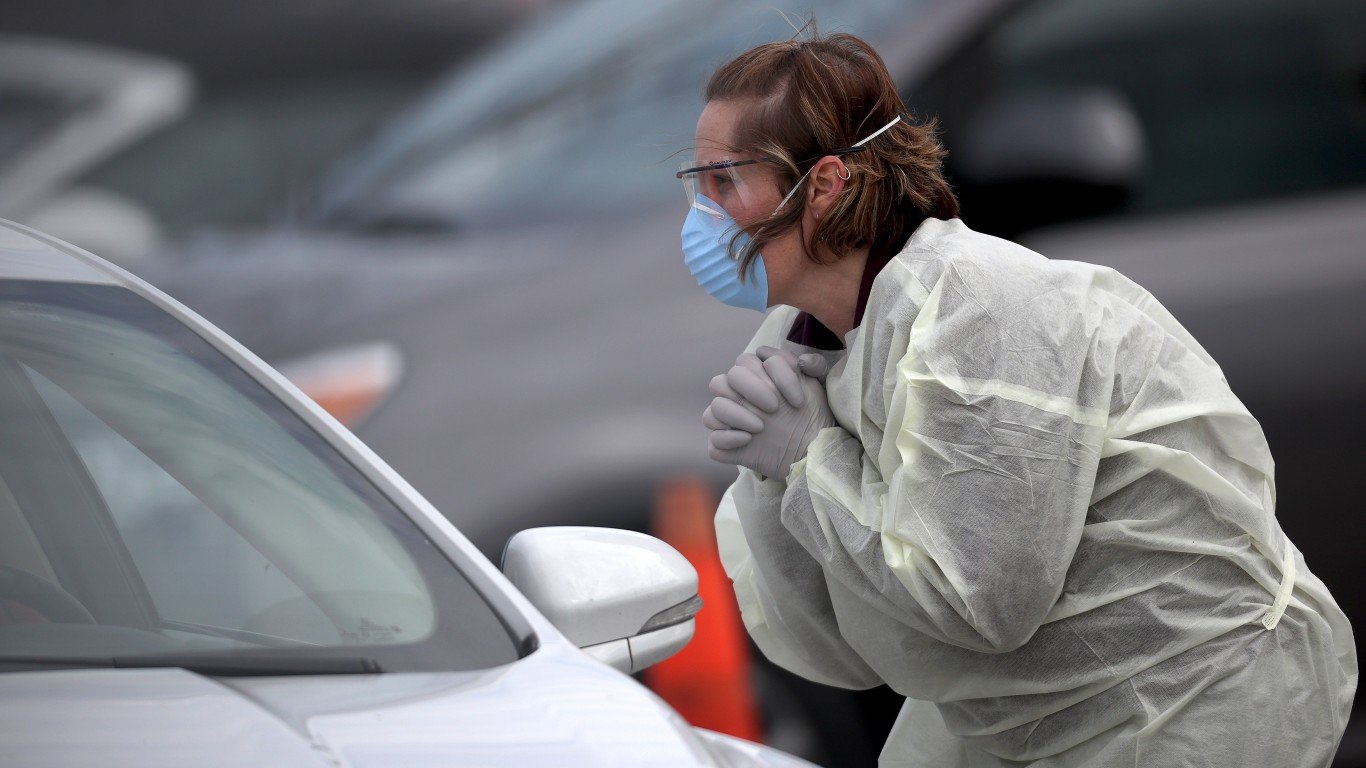
12. Maryland
> Avg. daily tests as pct. of expert recommendation: 43.2%
> Avg. daily test rate from May 5 – May 11, 2020: 65.7 new tests per 100,000 people (3,969 tests per day)
> Positive test rate: 20.3% (5th highest)
> COVID-19 infection rate as of May 11, 2020: 552.3 per 100,000 people — 9th highest (33,373 total cases)
> COVID-19 death rate as of May 11, 2020: 26.0 per 100,000 people — 10th highest (1,573 total deaths)
> Cumulative tests performed as of May 11, 2020: 164,780 (16th most)
> Date of first case: March 5, 2020
> Total population: 6.0 million (19th most)
[in-text-ad-2]
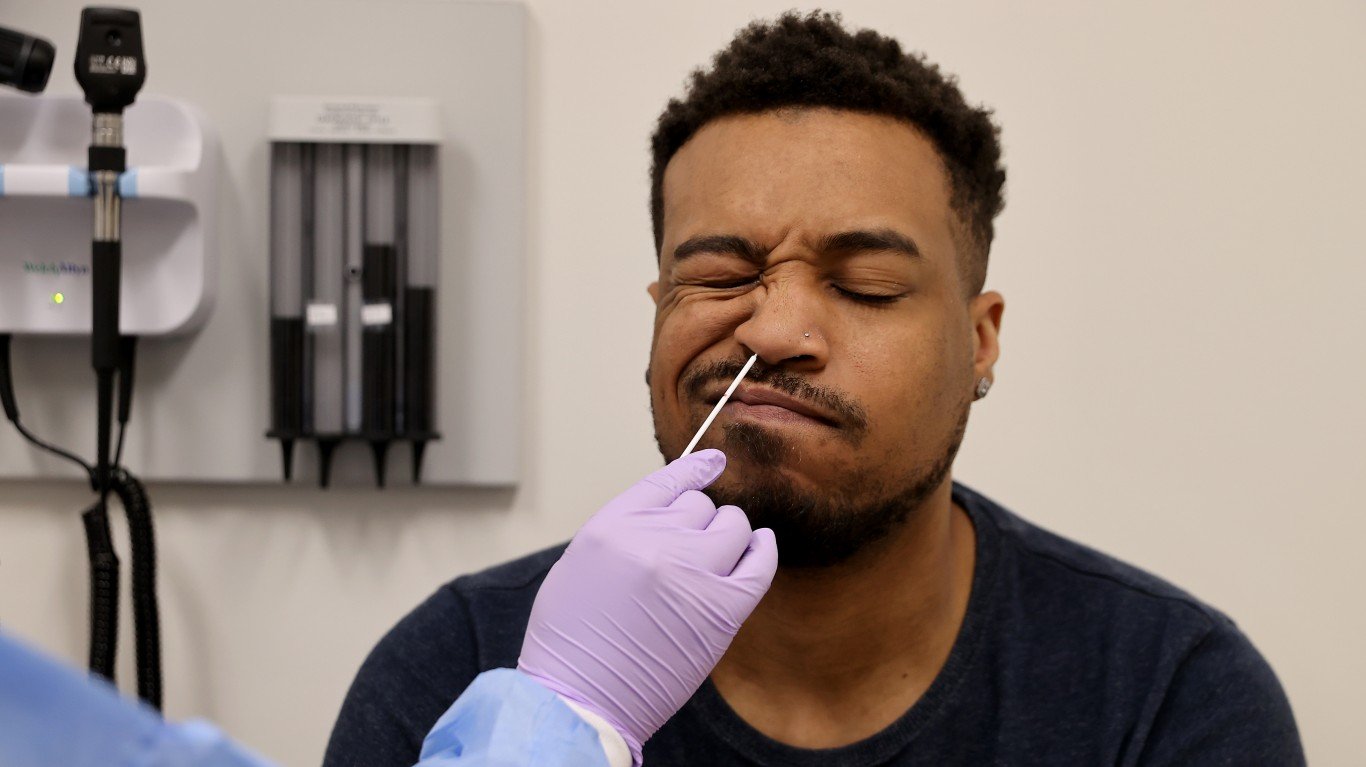
11. Virginia
> Avg. daily tests as pct. of expert recommendation: 42.3%
> Avg. daily test rate from May 5 – May 11, 2020: 64.3 new tests per 100,000 people (5,475 tests per day)
> Positive test rate: 15.9% (14th highest)
> COVID-19 infection rate as of May 11, 2020: 280.5 per 100,000 people — 19th highest (23,889 total cases)
> COVID-19 death rate as of May 11, 2020: 9.7 per 100,000 people — 22nd highest (823 total deaths)
> Cumulative tests performed as of May 11, 2020: 150,617 (17th most)
> Date of first case: March 7, 2020
> Total population: 8.5 million (12th most)
10. Nevada
> Avg. daily tests as pct. of expert recommendation: 41.5%
> Avg. daily test rate from May 5 – May 11, 2020: 63.1 new tests per 100,000 people (1,914 tests per day)
> Positive test rate: 10.5% (21st highest)
> COVID-19 infection rate as of May 11, 2020: 202.7 per 100,000 people — 23rd lowest (6,152 total cases)
> COVID-19 death rate as of May 11, 2020: 10.1 per 100,000 people — 19th highest (306 total deaths)
> Cumulative tests performed as of May 11, 2020: 58,863 (14th fewest)
> Date of first case: March 5, 2020
> Total population: 3.0 million (19th fewest)
[in-text-ad]
9. South Carolina
> Avg. daily tests as pct. of expert recommendation: 41.0%
> Avg. daily test rate from May 5 – May 11, 2020: 62.4 new tests per 100,000 people (3,171 tests per day)
> Positive test rate: 8.7% (25th lowest)
> COVID-19 infection rate as of May 11, 2020: 153.3 per 100,000 people — 15th lowest (7,792 total cases)
> COVID-19 death rate as of May 11, 2020: 6.8 per 100,000 people — 18th lowest (346 total deaths)
> Cumulative tests performed as of May 11, 2020: 89,968 (20th fewest)
> Date of first case: March 6, 2020
> Total population: 5.1 million (23rd most)
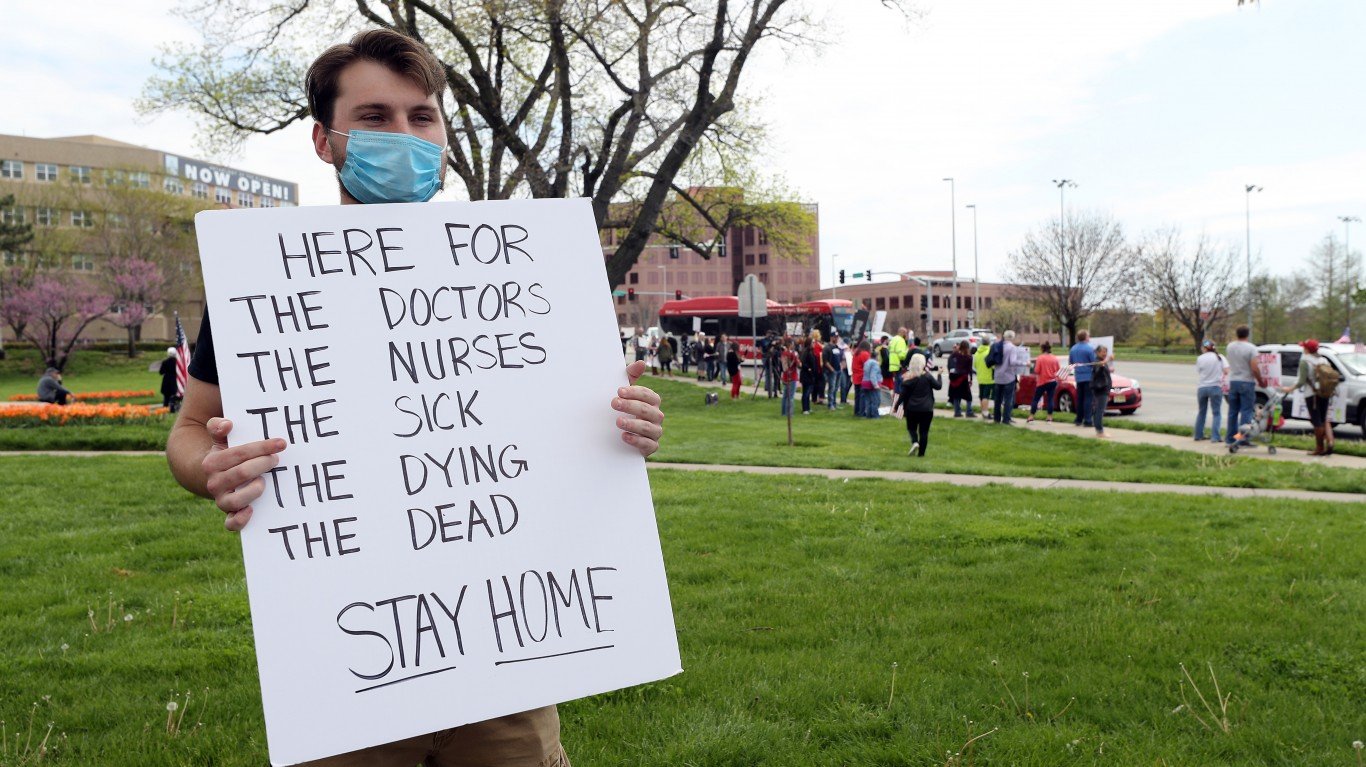
8. Missouri
> Avg. daily tests as pct. of expert recommendation: 40.5%
> Avg. daily test rate from May 5 – May 11, 2020: 61.5 new tests per 100,000 people (3,770 tests per day)
> Positive test rate: 8.2% (24th lowest)
> COVID-19 infection rate as of May 11, 2020: 161.9 per 100,000 people — 17th lowest (9,918 total cases)
> COVID-19 death rate as of May 11, 2020: 8.0 per 100,000 people — 24th lowest (488 total deaths)
> Cumulative tests performed as of May 11, 2020: 121,296 (23rd most)
> Date of first case: March 7, 2020
> Total population: 6.1 million (18th most)

7. Colorado
> Avg. daily tests as pct. of expert recommendation: 38.8%
> Avg. daily test rate from May 5 – May 11, 2020: 58.9 new tests per 100,000 people (3,356 tests per day)
> Positive test rate: 18.6% (8th highest)
> COVID-19 infection rate as of May 11, 2020: 349.0 per 100,000 people — 16th highest (19,879 total cases)
> COVID-19 death rate as of May 11, 2020: 17.3 per 100,000 people — 13th highest (987 total deaths)
> Cumulative tests performed as of May 11, 2020: 106,761 (25th fewest)
> Date of first case: March 5, 2020
> Total population: 5.7 million (21st most)
[in-text-ad-2]

6. Texas
> Avg. daily tests as pct. of expert recommendation: 38.7%
> Avg. daily test rate from May 5 – May 11, 2020: 58.9 new tests per 100,000 people (16,900 tests per day)
> Positive test rate: 7.6% (20th lowest)
> COVID-19 infection rate as of May 11, 2020: 138.9 per 100,000 people — 11th lowest (39,869 total cases)
> COVID-19 death rate as of May 11, 2020: 3.8 per 100,000 people — 11th lowest (1,100 total deaths)
> Cumulative tests performed as of May 11, 2020: 525,697 (4th most)
> Date of first case: February 12, 2020
> Total population: 28.7 million (2nd most)

5. Oregon
> Avg. daily tests as pct. of expert recommendation: 34.7%
> Avg. daily test rate from May 5 – May 11, 2020: 52.8 new tests per 100,000 people (2,213 tests per day)
> Positive test rate: 4.2% (7th lowest)
> COVID-19 infection rate as of May 11, 2020: 76.9 per 100,000 people — 5th lowest (3,222 total cases)
> COVID-19 death rate as of May 11, 2020: 3.1 per 100,000 people — 6th lowest (130 total deaths)
> Cumulative tests performed as of May 11, 2020: 77,542 (17th fewest)
> Date of first case: February 28, 2020
> Total population: 4.2 million (24th fewest)
[in-text-ad]
4. Pennsylvania
> Avg. daily tests as pct. of expert recommendation: 31.8%
> Avg. daily test rate from May 5 – May 11, 2020: 48.3 new tests per 100,000 people (6,181 tests per day)
> Positive test rate: 19.8% (7th highest)
> COVID-19 infection rate as of May 11, 2020: 446.3 per 100,000 people — 11th highest (57,154 total cases)
> COVID-19 death rate as of May 11, 2020: 29.1 per 100,000 people — 8th highest (3,731 total deaths)
> Cumulative tests performed as of May 11, 2020: 288,858 (9th most)
> Date of first case: March 6, 2020
> Total population: 12.8 million (5th most)
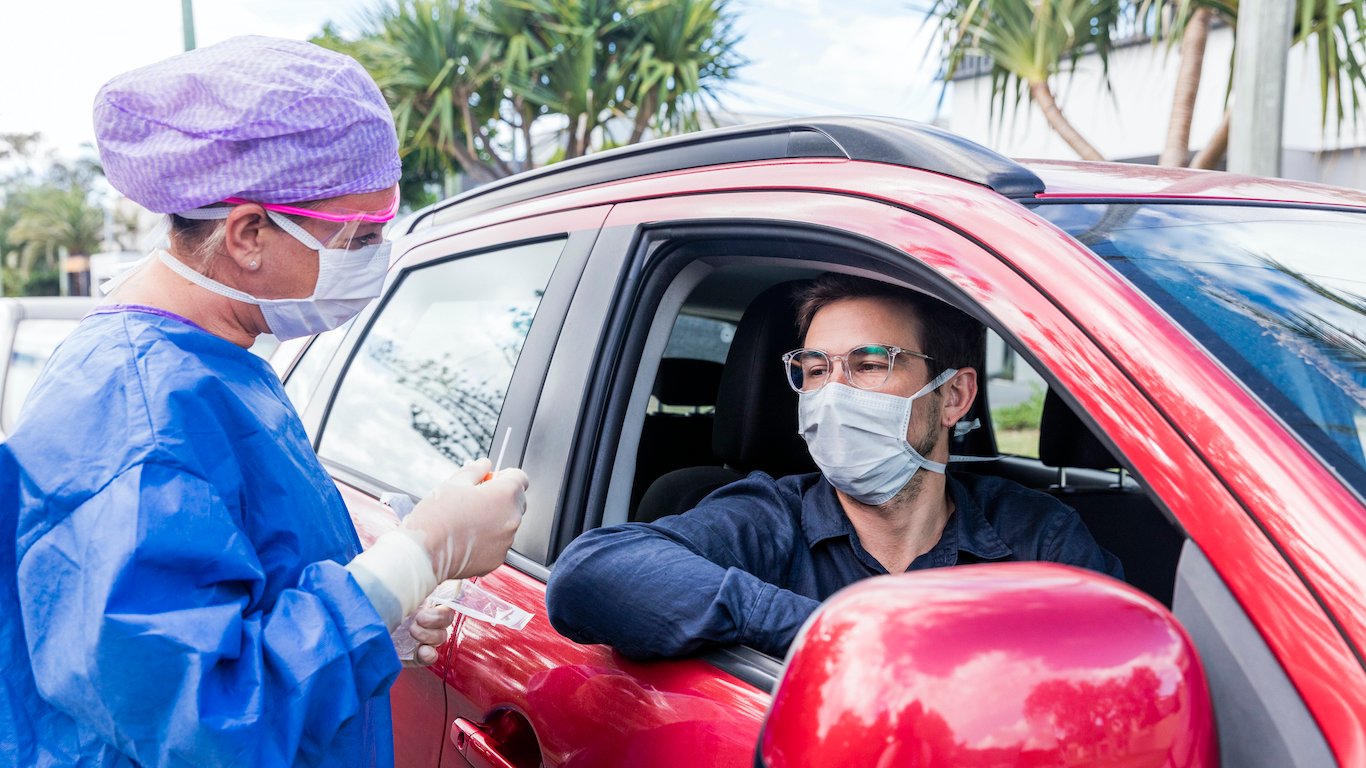
3. Hawaii
> Avg. daily tests as pct. of expert recommendation: 25.3%
> Avg. daily test rate from May 5 – May 11, 2020: 38.4 new tests per 100,000 people (545 tests per day)
> Positive test rate: 1.7% (2nd lowest)
> COVID-19 infection rate as of May 11, 2020: 44.6 per 100,000 people — 2nd lowest (634 total cases)
> COVID-19 death rate as of May 11, 2020: 1.2 per 100,000 people — the lowest (17 total deaths)
> Cumulative tests performed as of May 11, 2020: 37,683 (10th fewest)
> Date of first case: March 6, 2020
> Total population: 1.4 million (11th fewest)
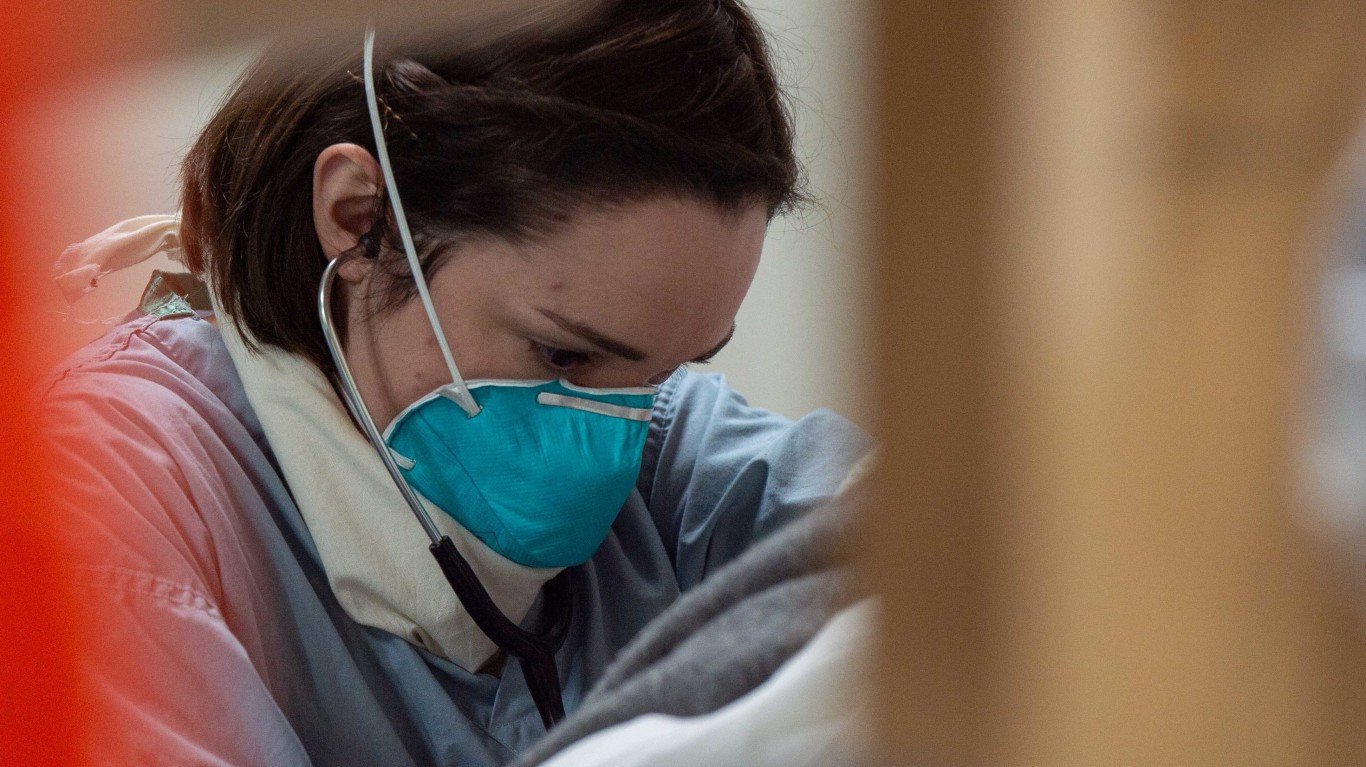
2. Maine
> Avg. daily tests as pct. of expert recommendation: 19.7%
> Avg. daily test rate from May 5 – May 11, 2020: 29.9 new tests per 100,000 people (400 tests per day)
> Positive test rate: 6.2% (14th lowest)
> COVID-19 infection rate as of May 11, 2020: 109.2 per 100,000 people — 7th lowest (1,462 total cases)
> COVID-19 death rate as of May 11, 2020: 4.9 per 100,000 people — 14th lowest (65 total deaths)
> Cumulative tests performed as of May 11, 2020: 23,554 (4th fewest)
> Date of first case: March 12, 2020
> Total population: 1.3 million (9th fewest)
[in-text-ad-2]
1. Idaho
> Avg. daily tests as pct. of expert recommendation: 12.4%
> Avg. daily test rate from May 5 – May 11, 2020: 18.8 new tests per 100,000 people (330 tests per day)
> Positive test rate: 7.0% (17th lowest)
> COVID-19 infection rate as of May 11, 2020: 116.8 per 100,000 people — 8th lowest (2,049 total cases)
> COVID-19 death rate as of May 11, 2020: 3.8 per 100,000 people — 10th lowest (67 total deaths)
> Cumulative tests performed as of May 11, 2020: 31,961 (8th fewest)
> Date of first case: March 1March 2020
> Total population: 1.8 million (12th fewest)
Methodology
In order to determine how far each state is from meeting testing rates recommended by experts, 24/7 Wall St. calculated the average daily testing rate over the week ending May 11 for every 100,000 state residents. We then calculated that rate as a percentage of the recommended 152 daily tests per 100,000 people — the minimum rate necessary to safely reopen, according to Harvard researchers.
Confirmed COVID-19 cases and deaths, as well as data on testing and testing results, in each state through May 11 came from state and local health departments. Population figures are one-year estimates from the U.S. Census Bureau’s 2018 American Community Survey.
Take This Retirement Quiz To Get Matched With A Financial Advisor (Sponsored)
Take the quiz below to get matched with a financial advisor today.
Each advisor has been vetted by SmartAsset and is held to a fiduciary standard to act in your best interests.
Here’s how it works:
1. Answer SmartAsset advisor match quiz
2. Review your pre-screened matches at your leisure. Check out the
advisors’ profiles.
3. Speak with advisors at no cost to you. Have an introductory call on the phone or introduction in person and choose whom to work with in the future
Take the retirement quiz right here.
Thank you for reading! Have some feedback for us?
Contact the 24/7 Wall St. editorial team.
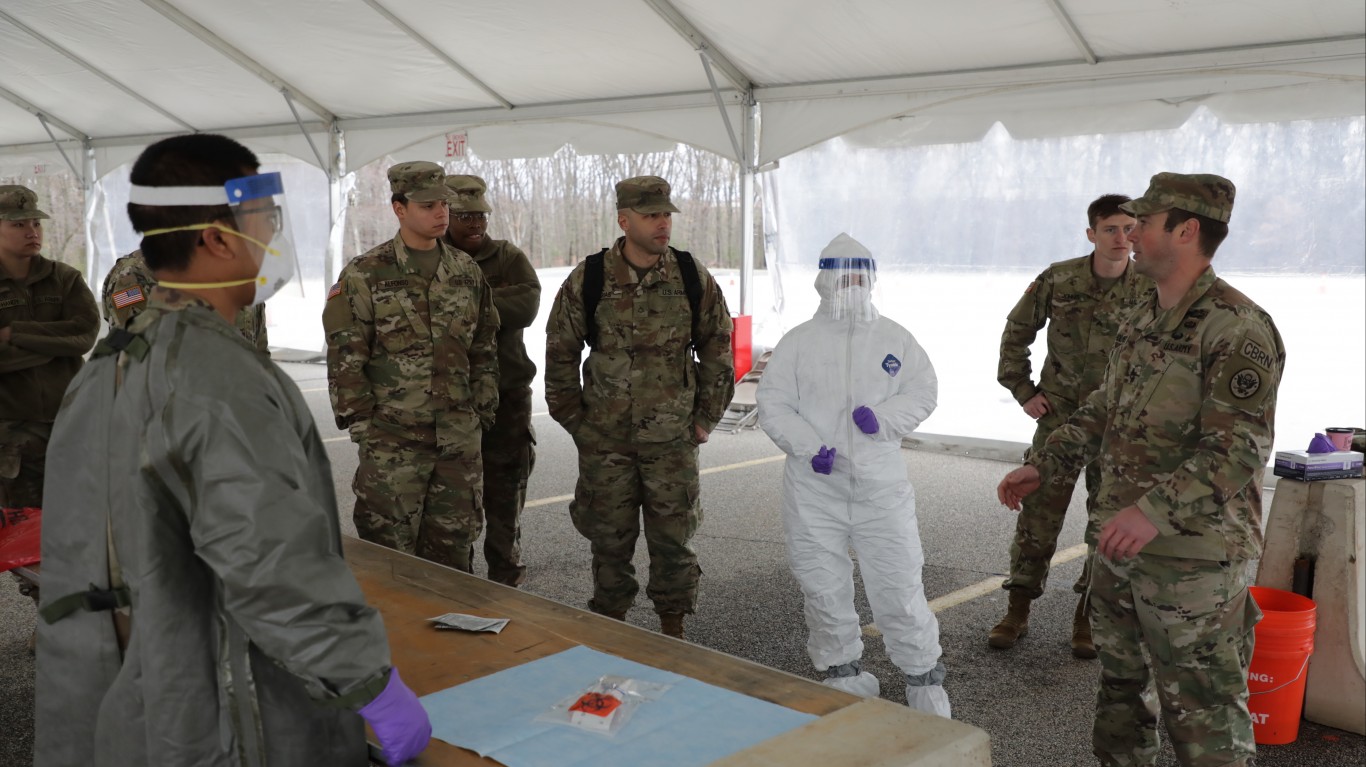
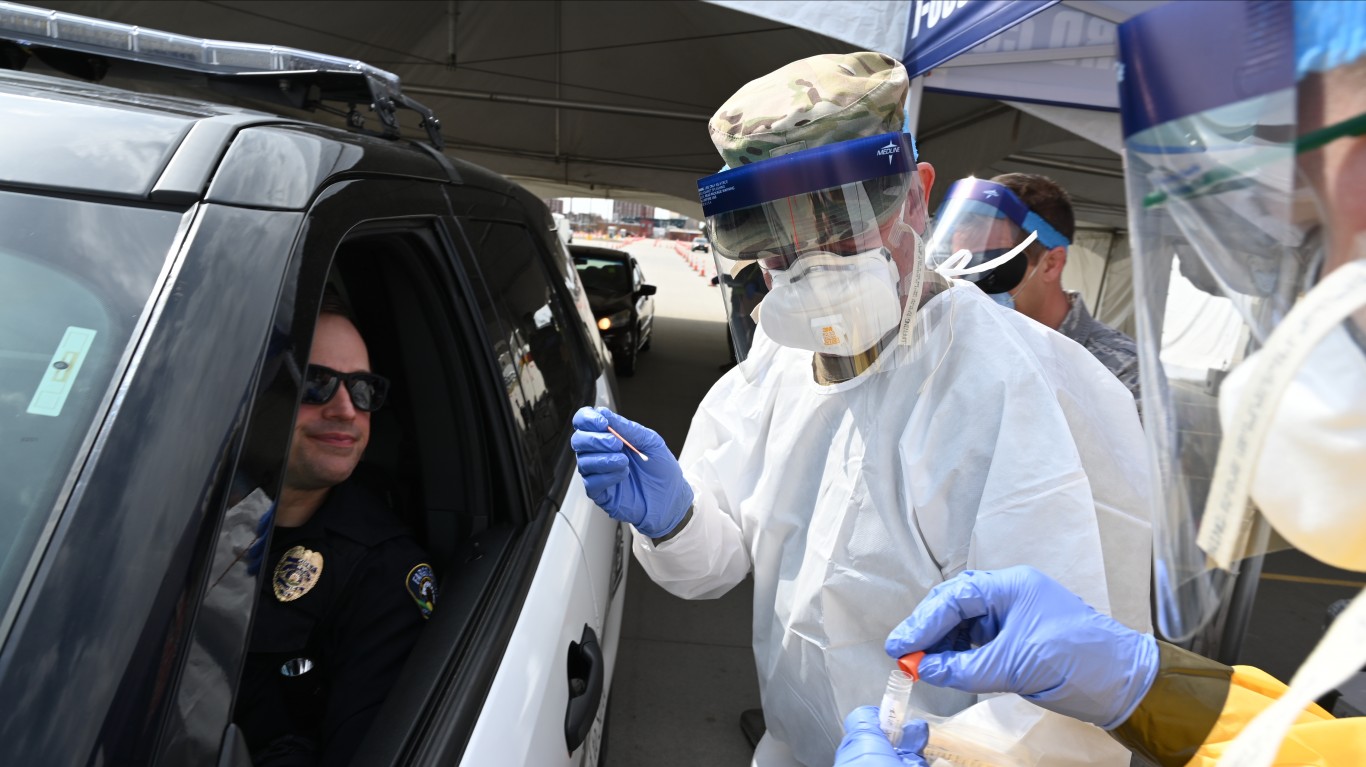
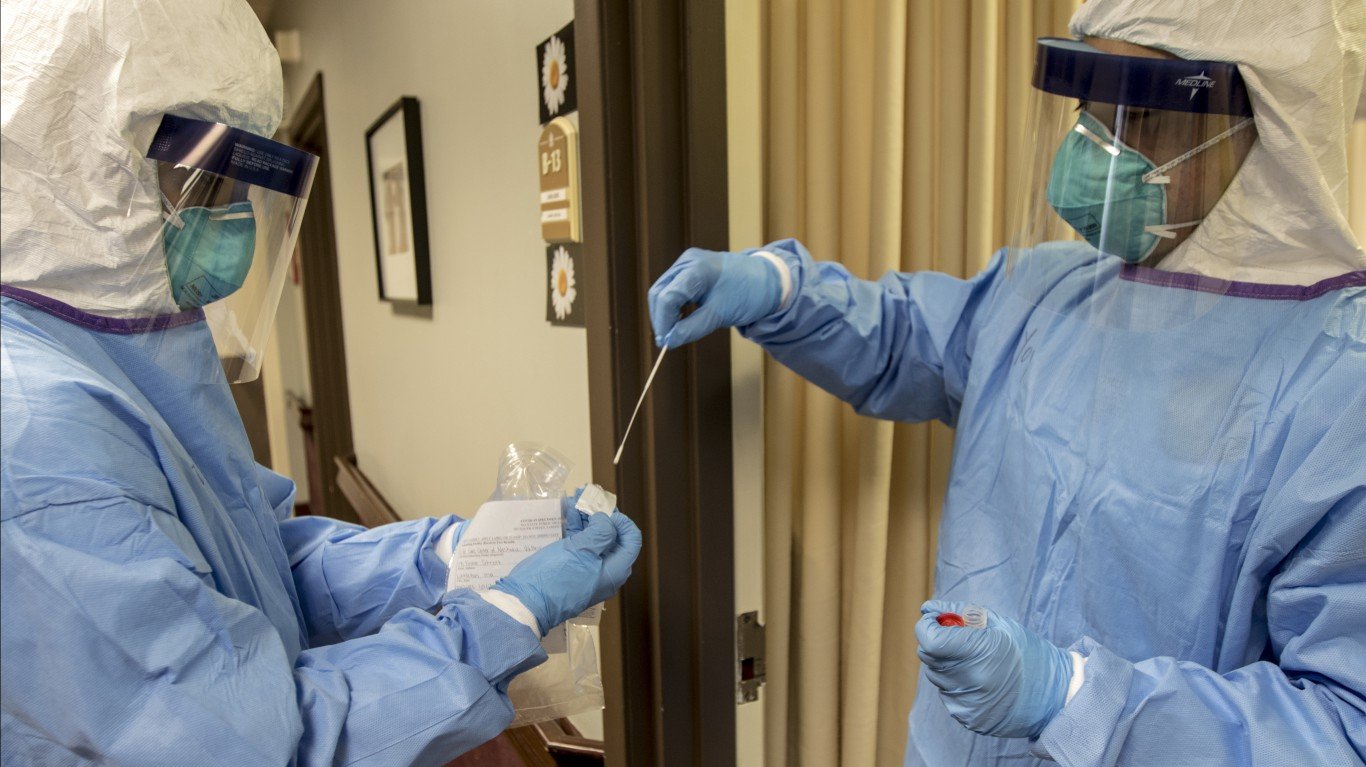
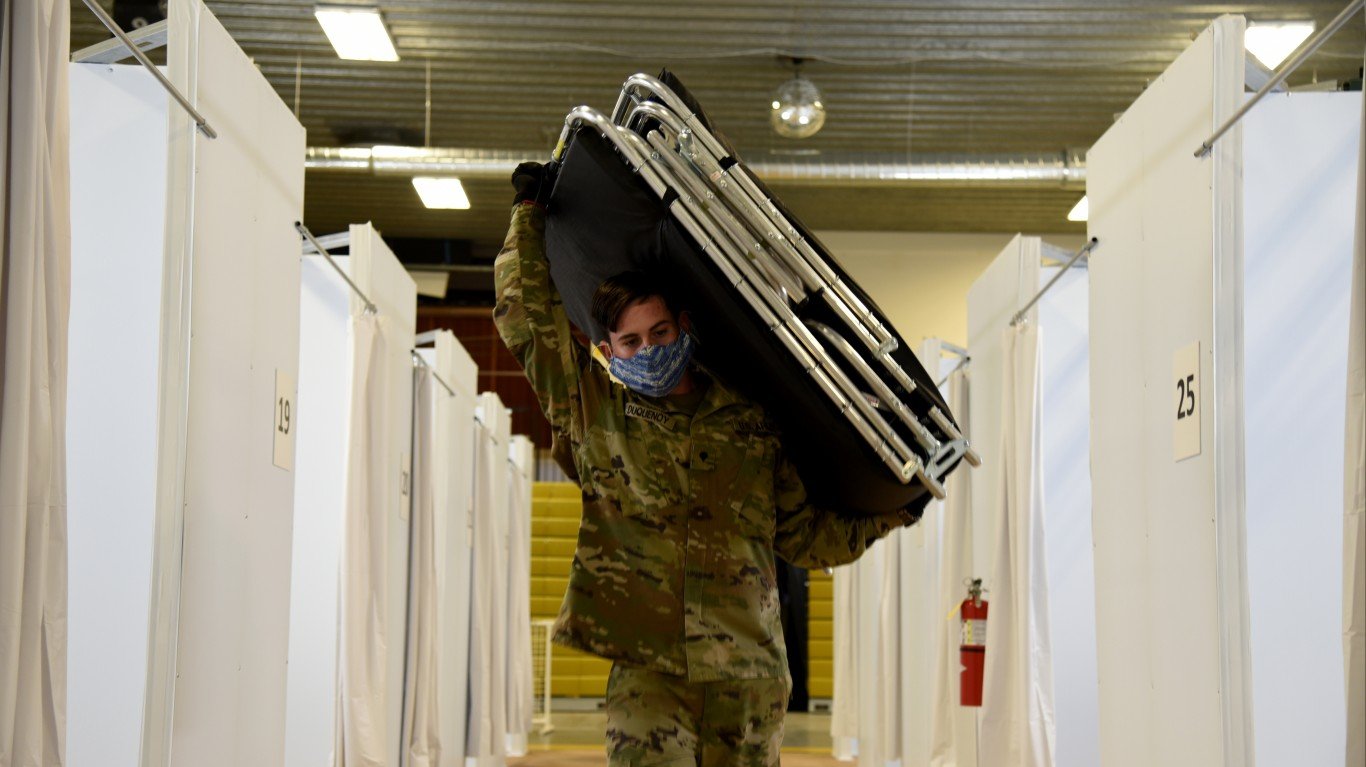
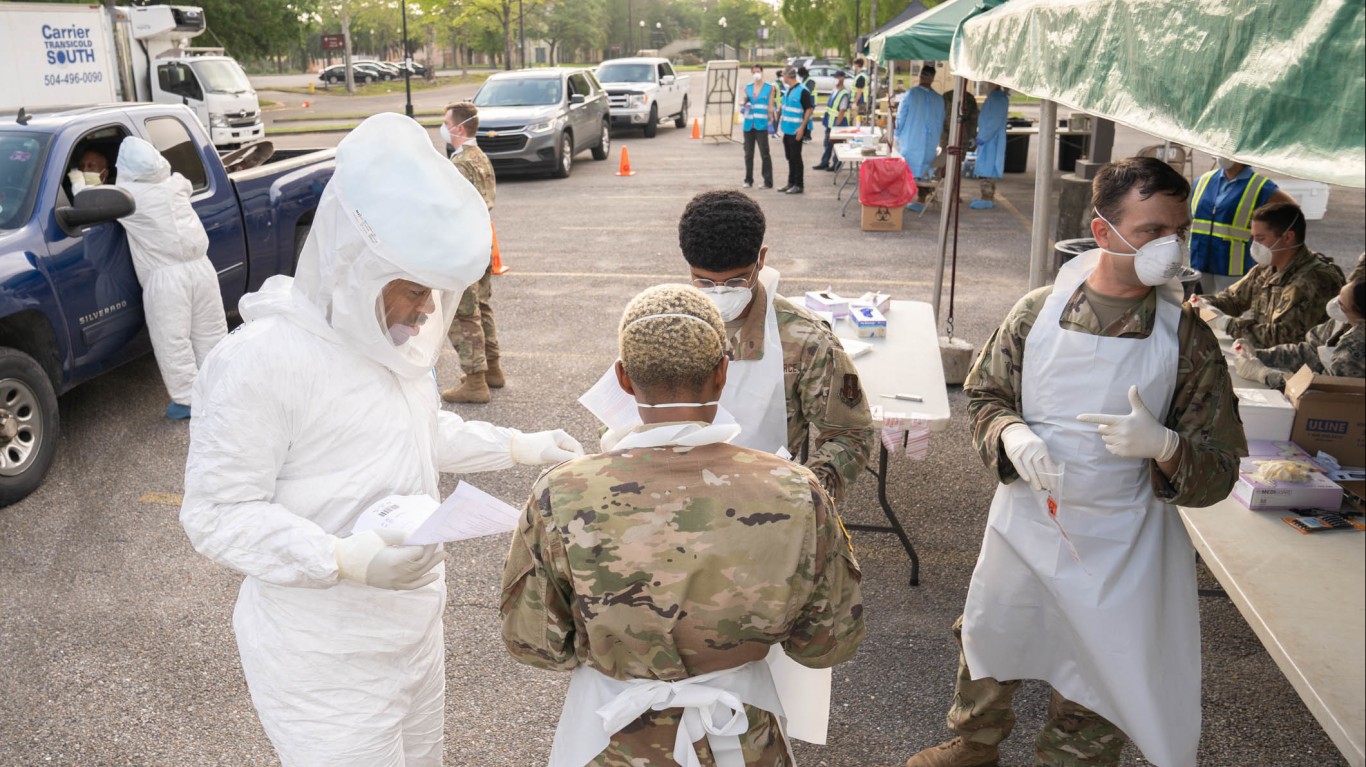
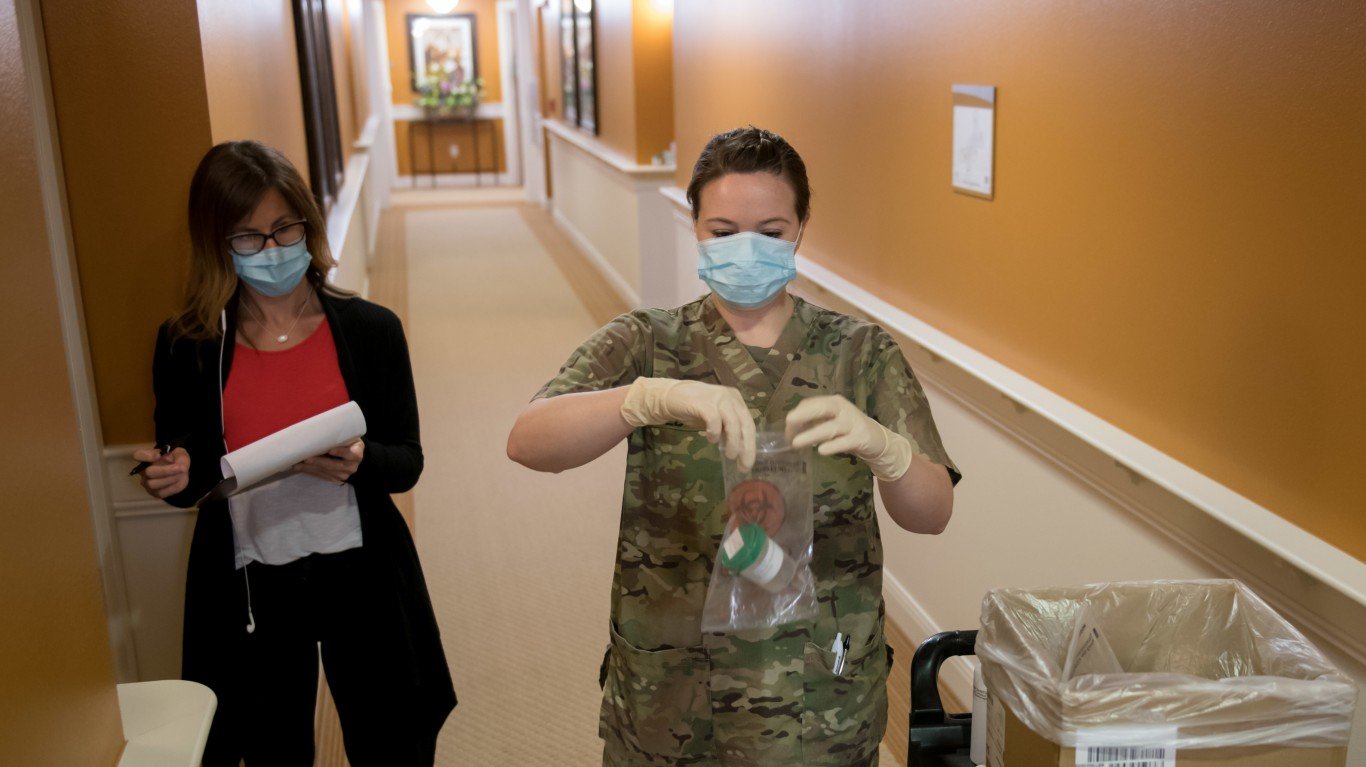
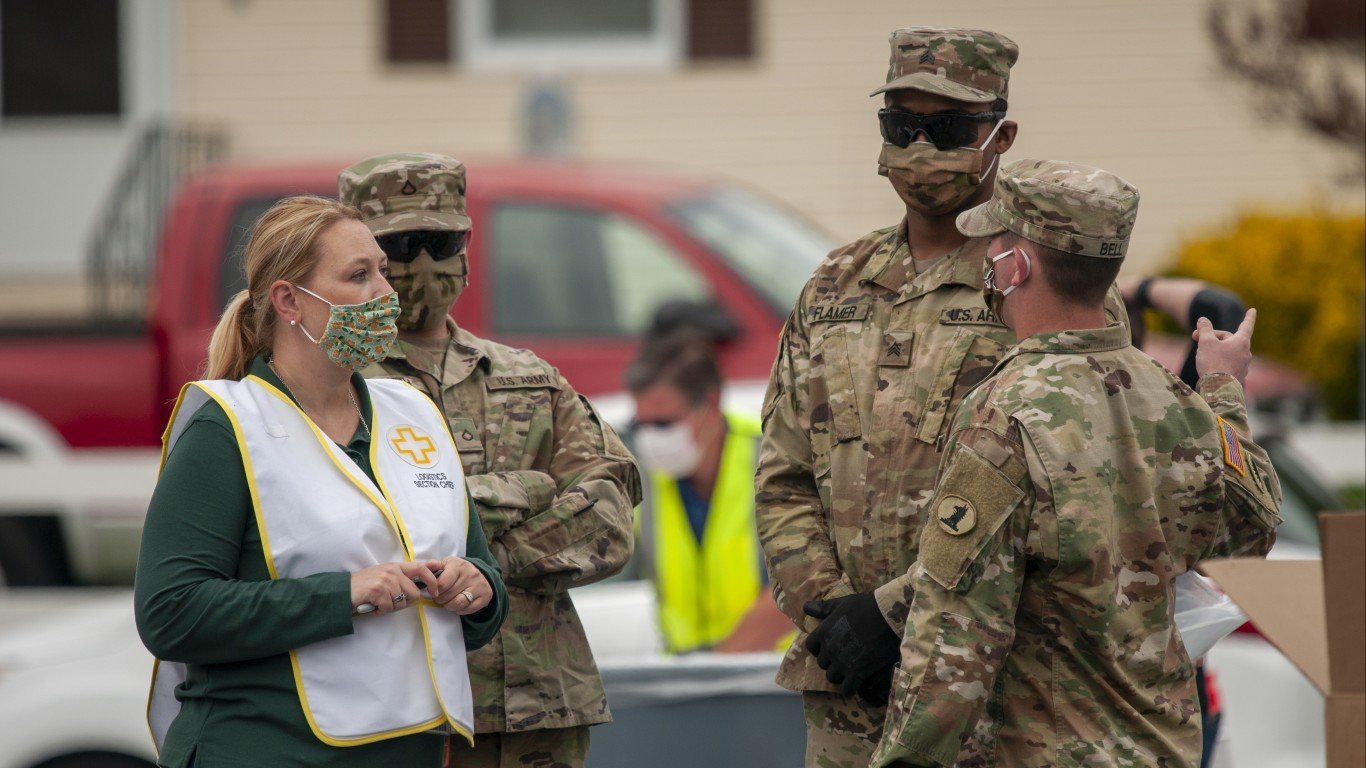
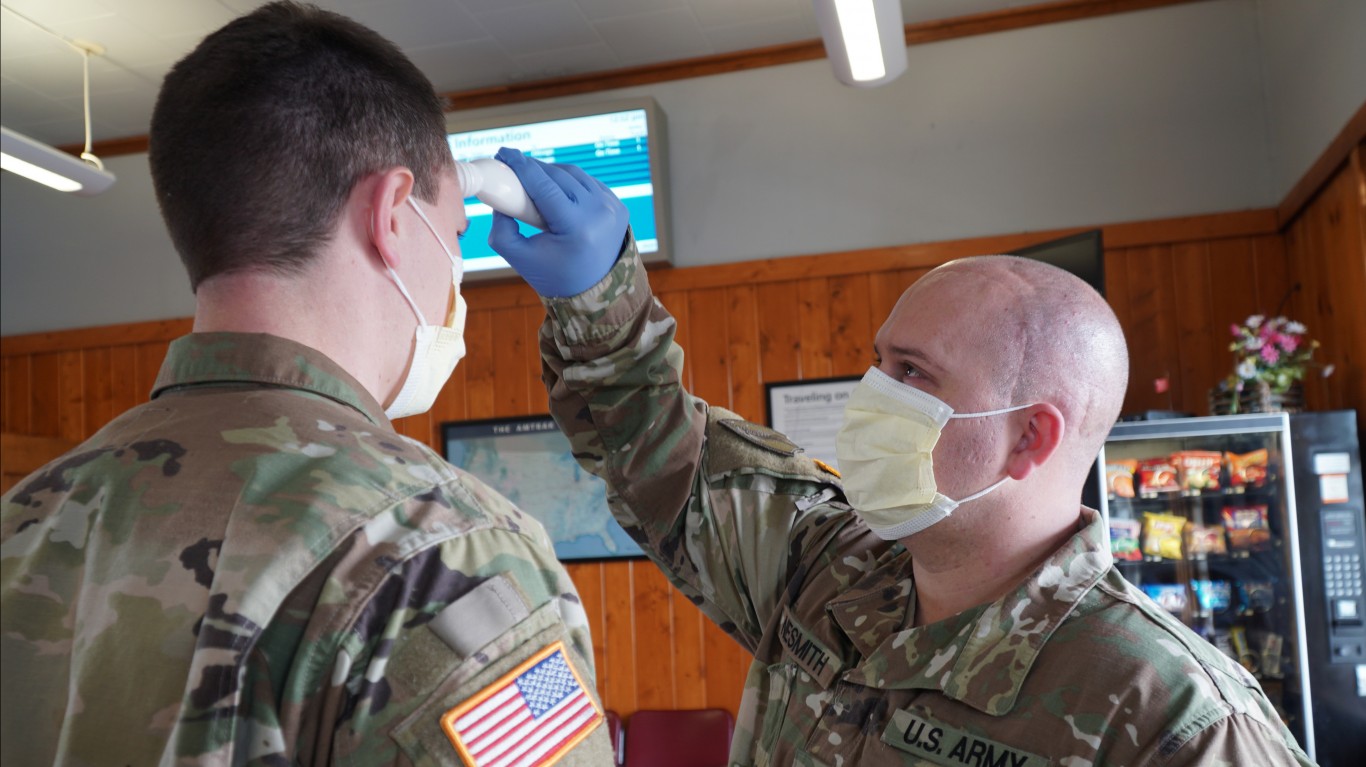
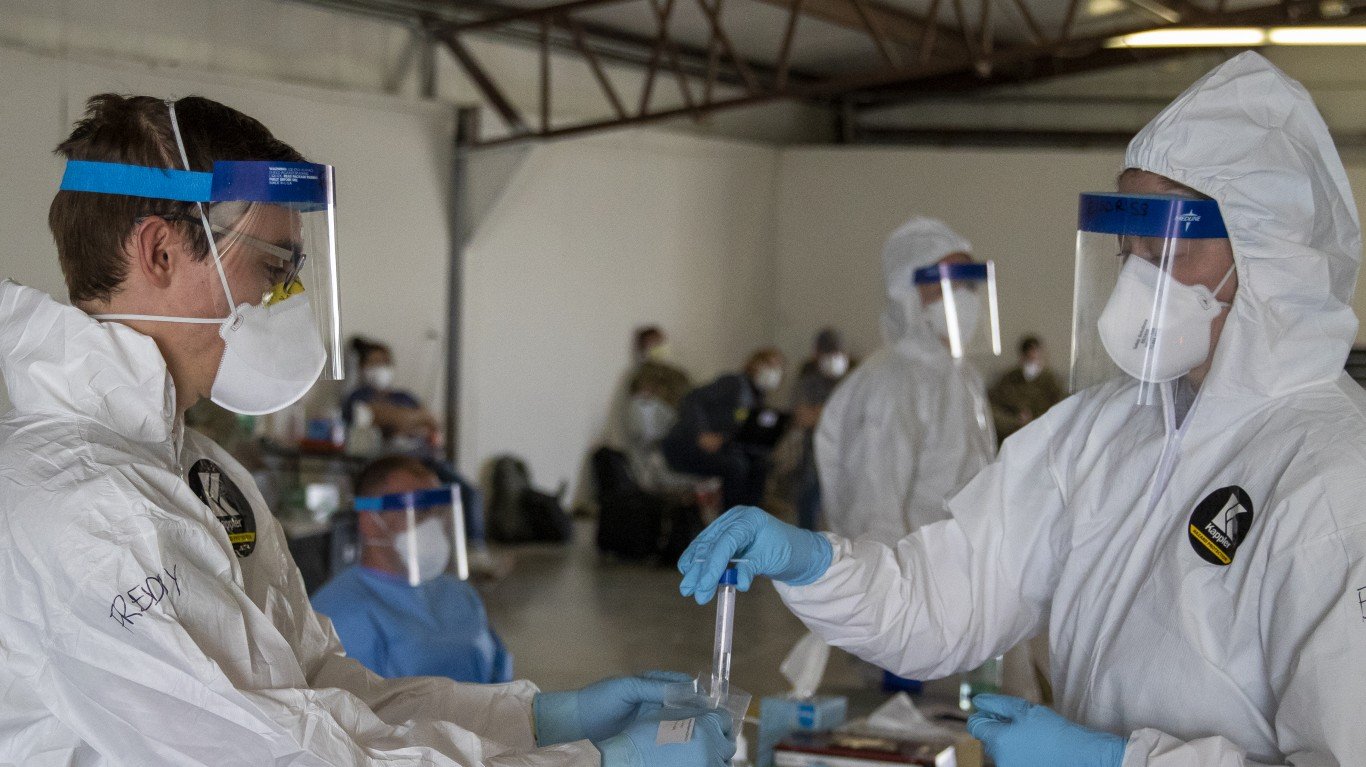
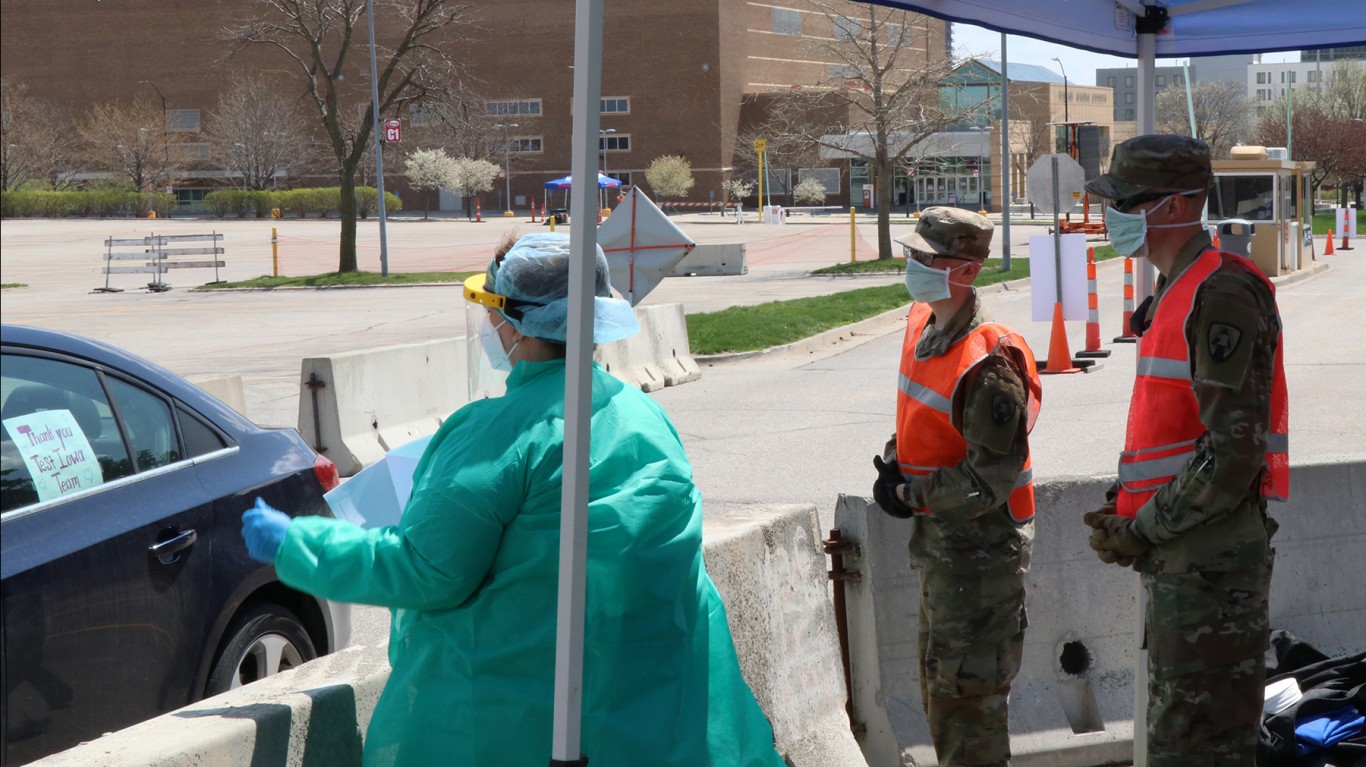
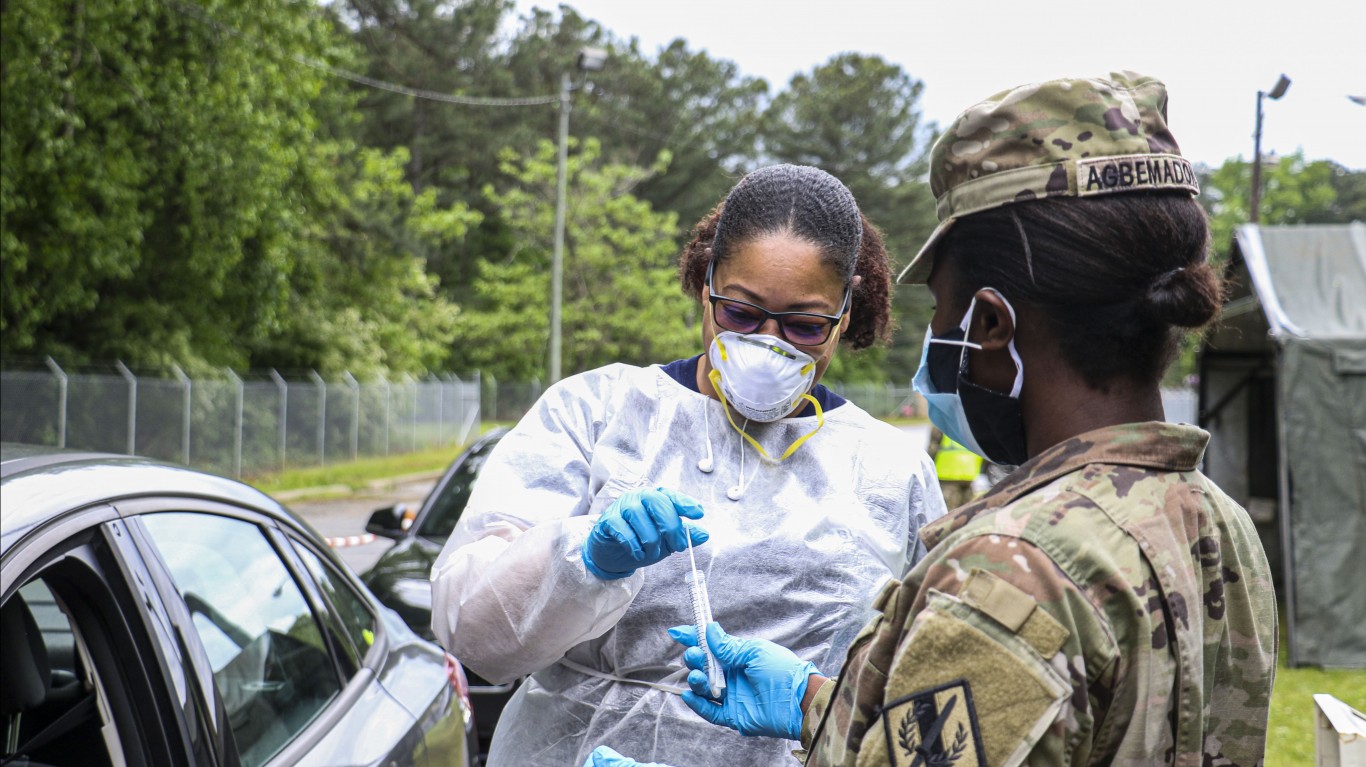
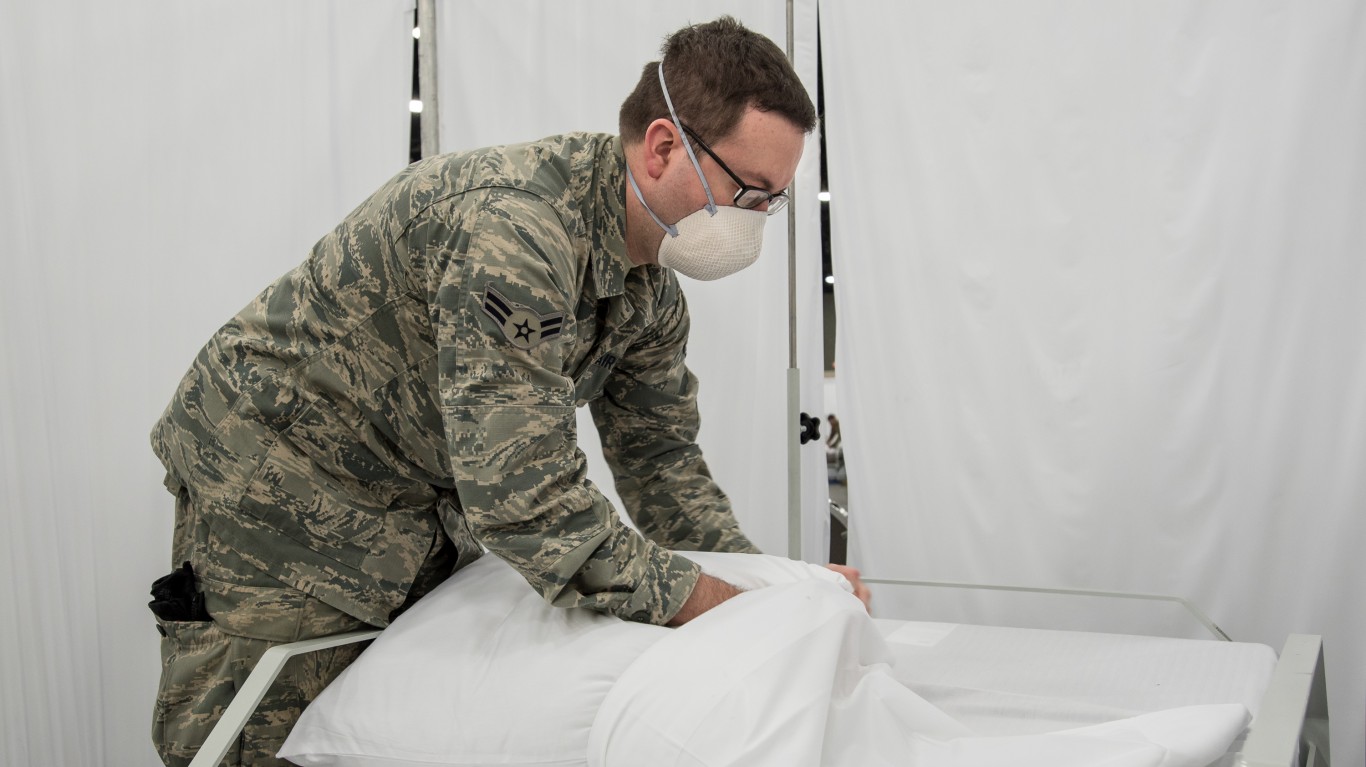
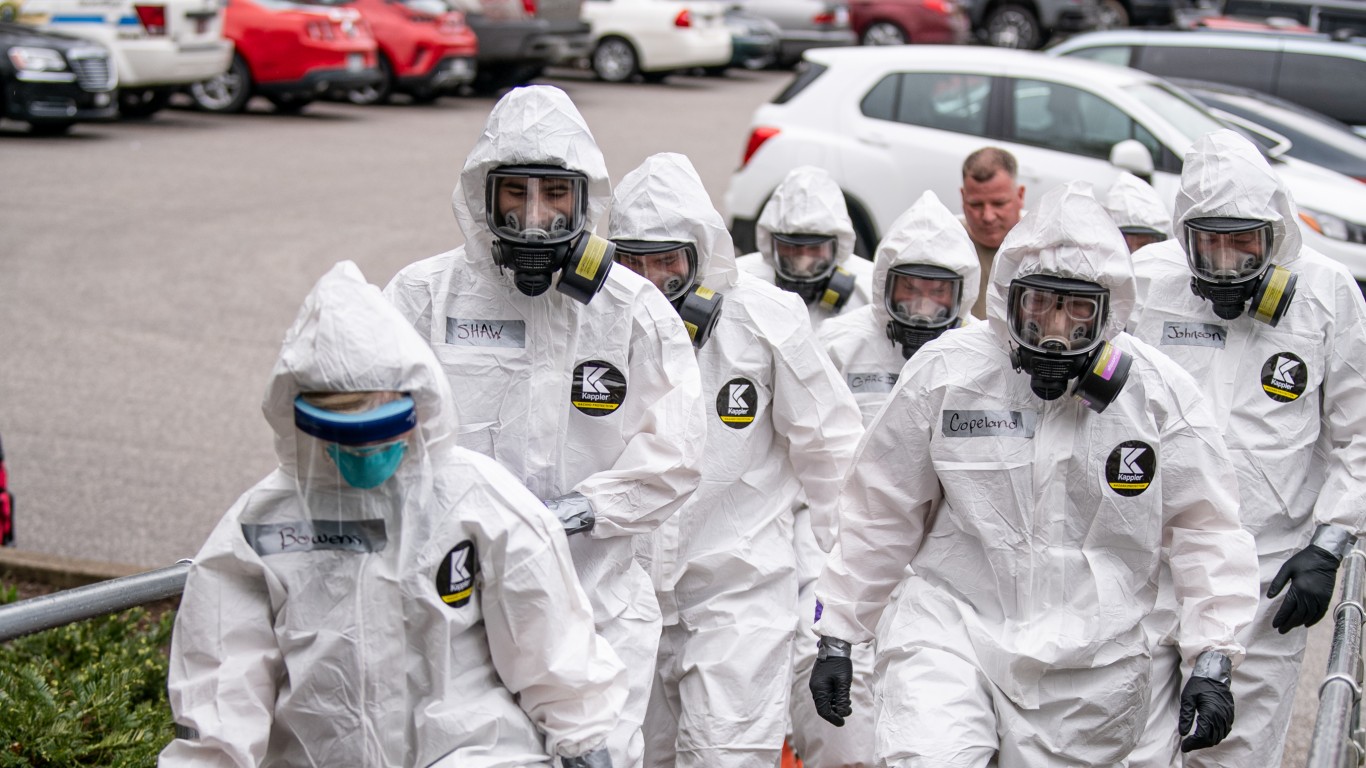
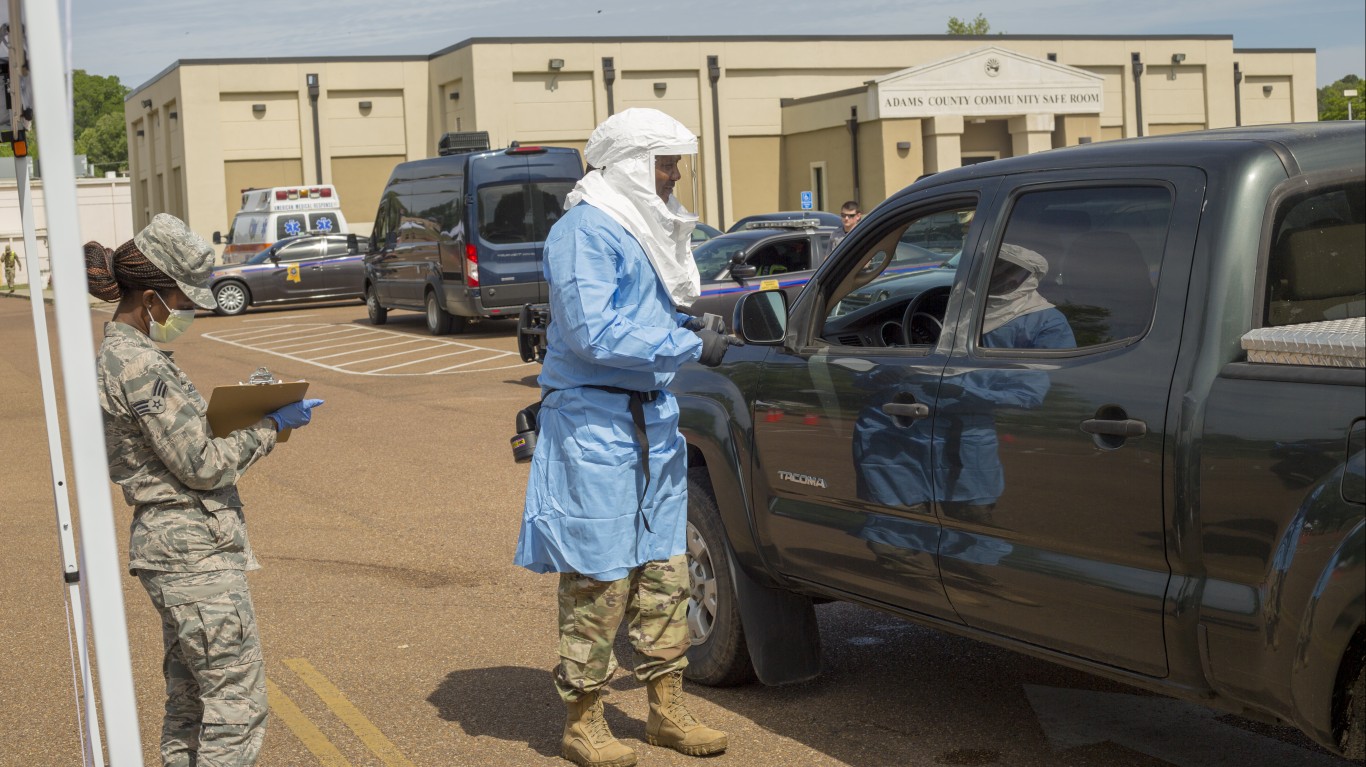
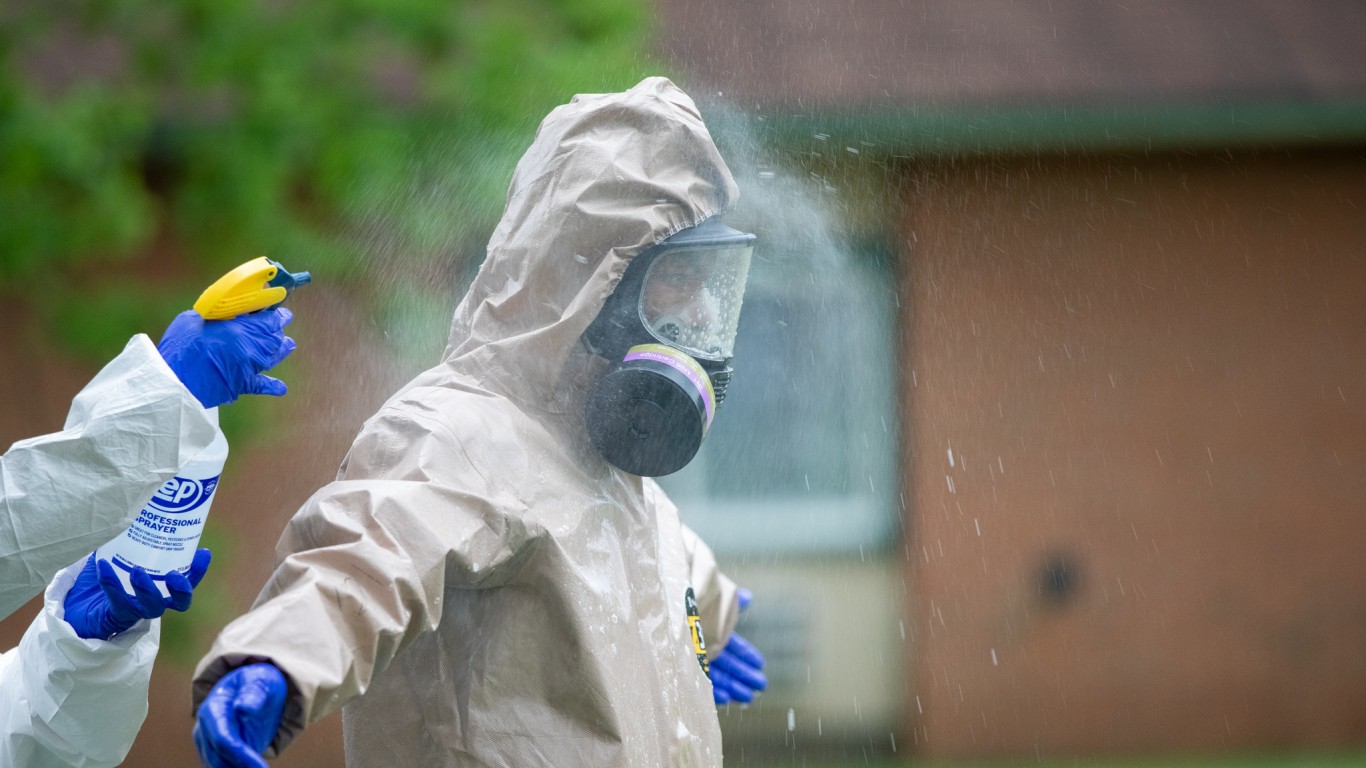
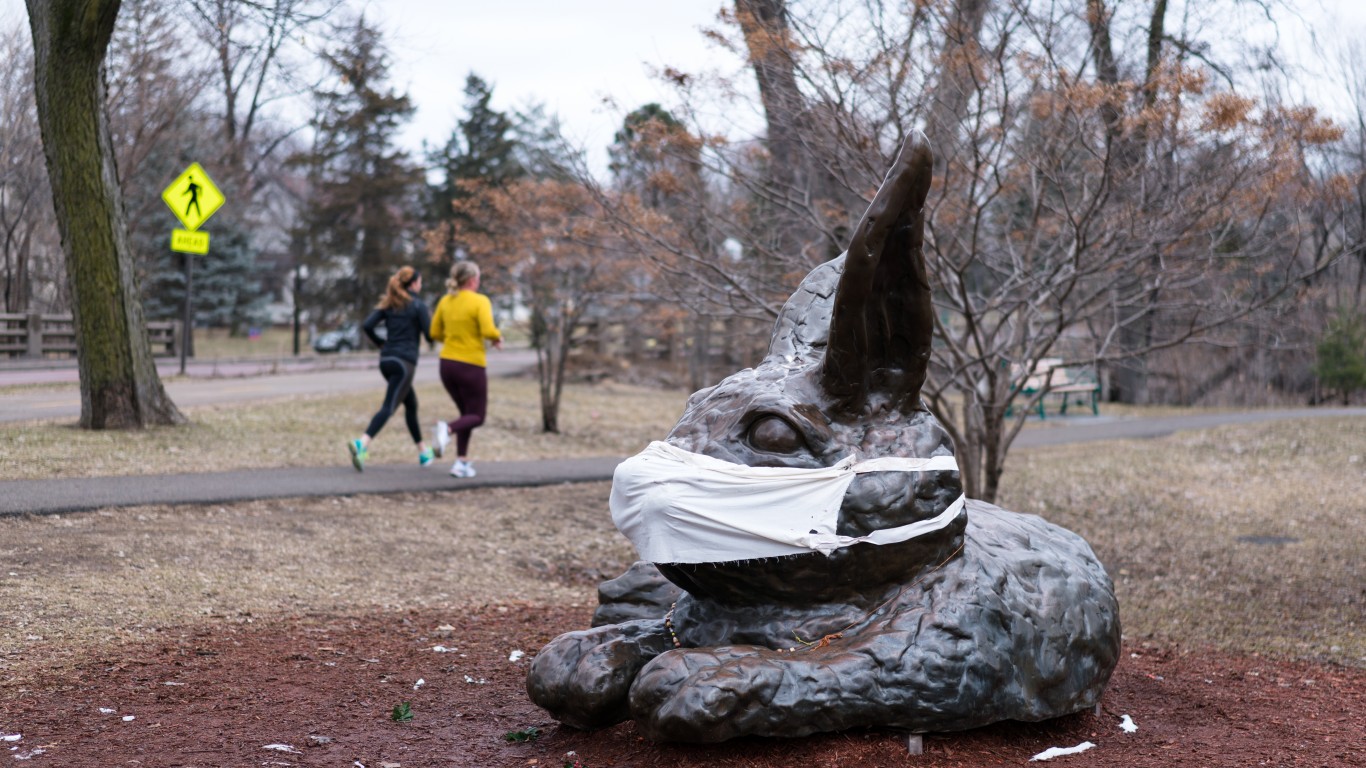
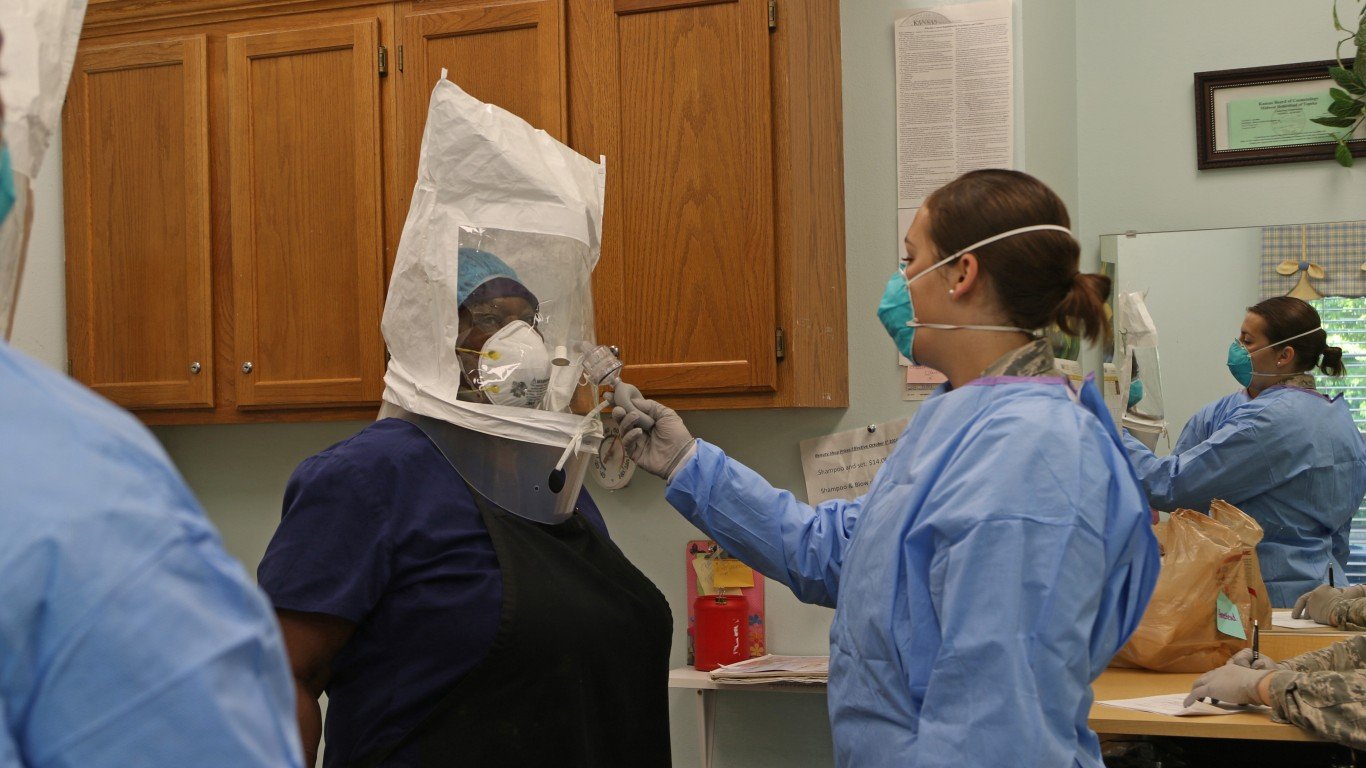
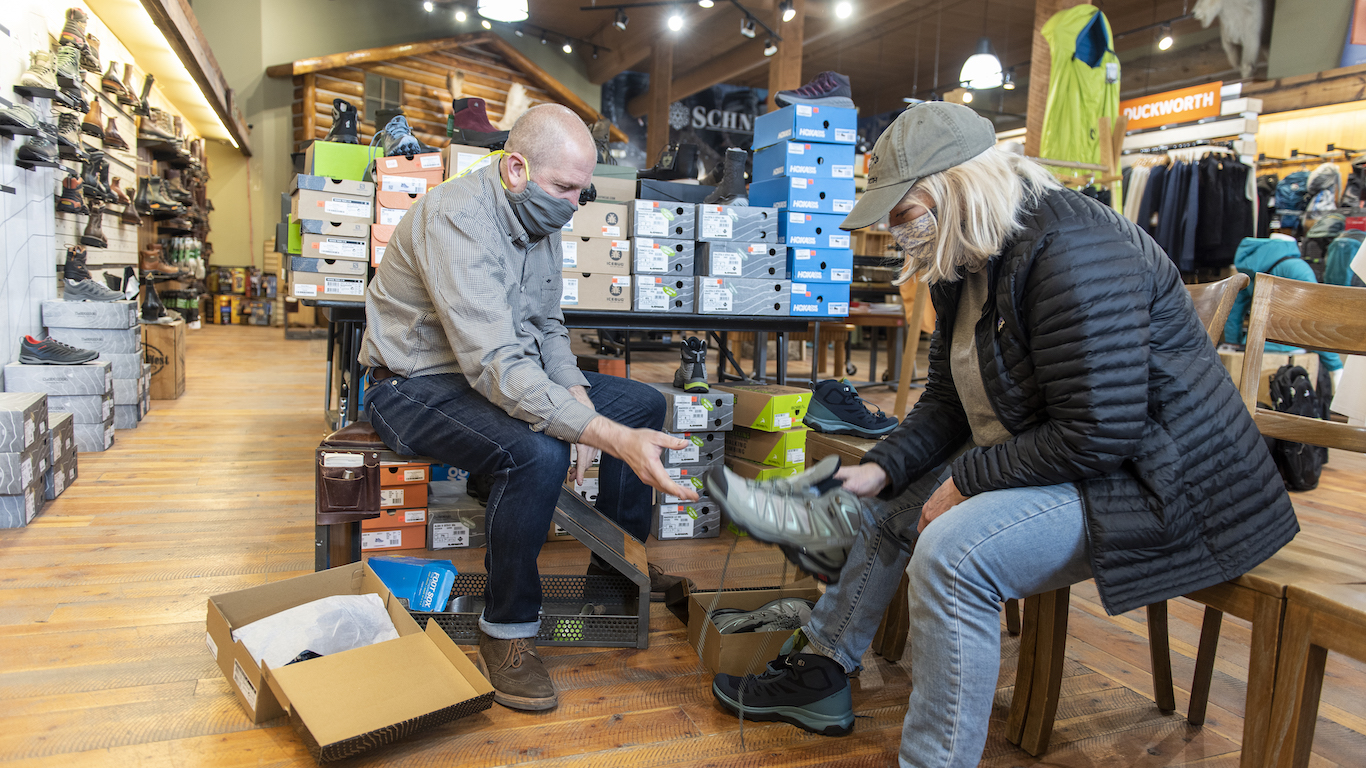 24/7 Wall St.
24/7 Wall St.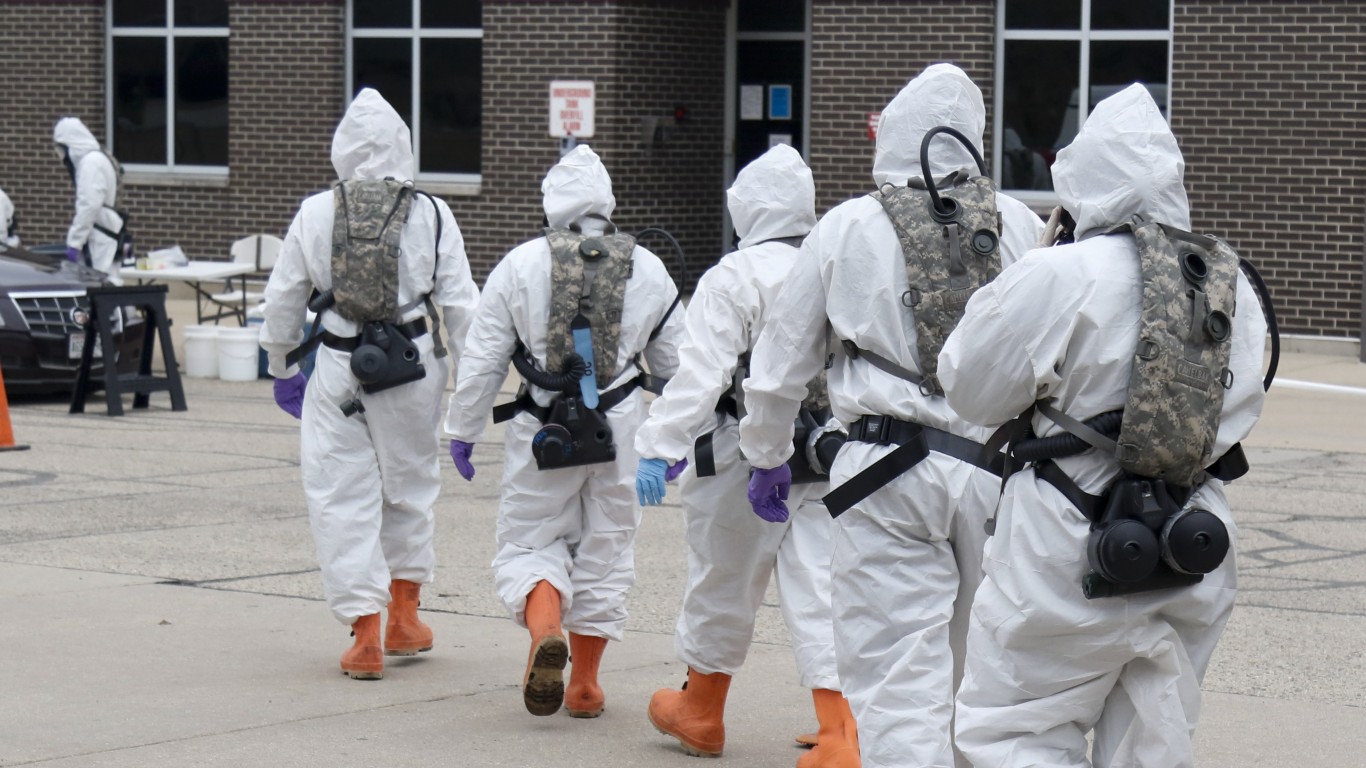
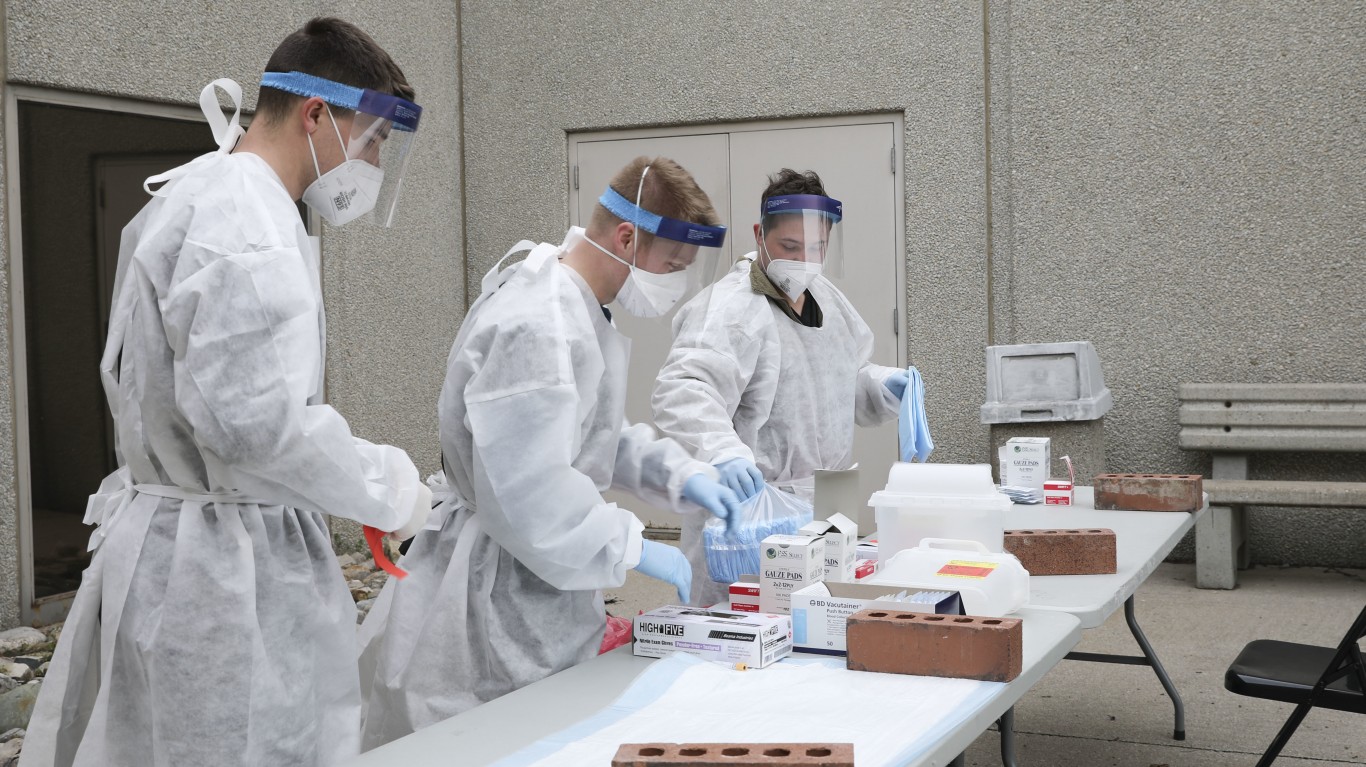
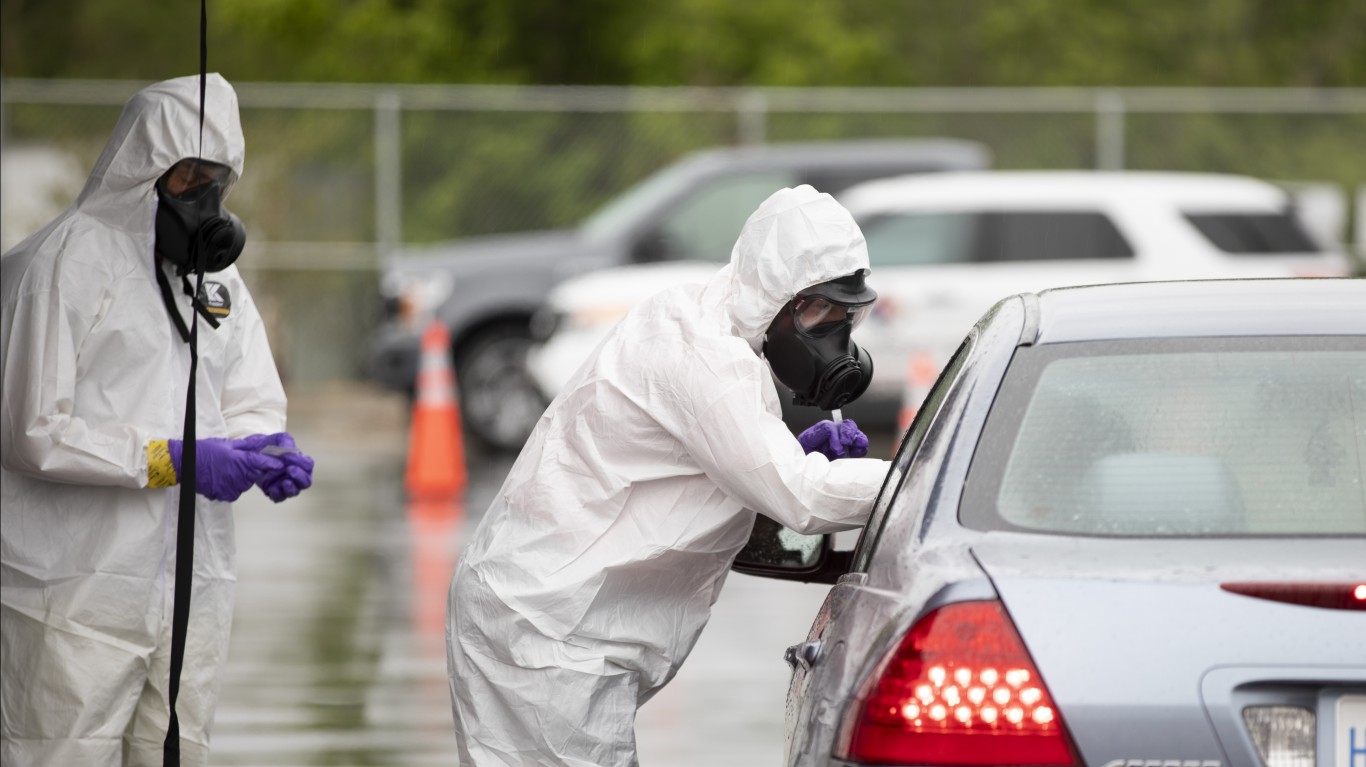

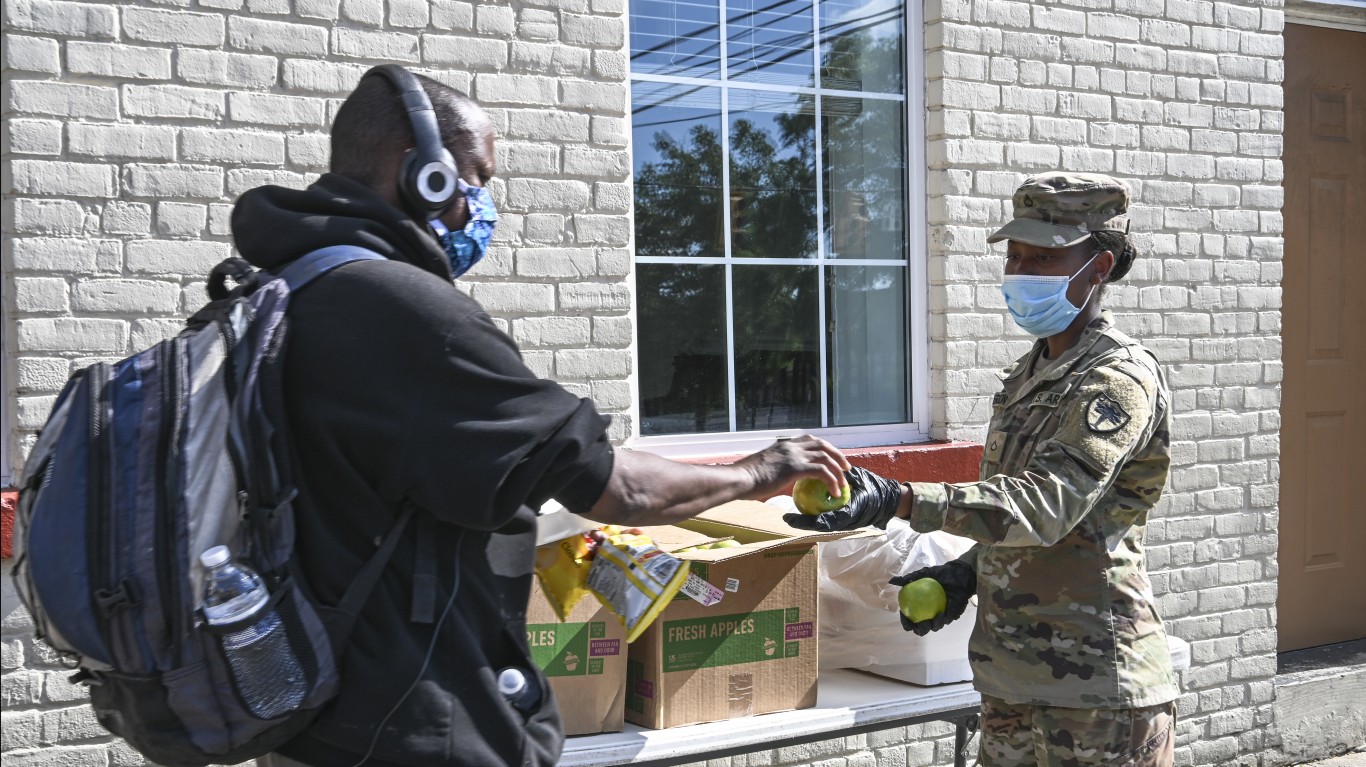
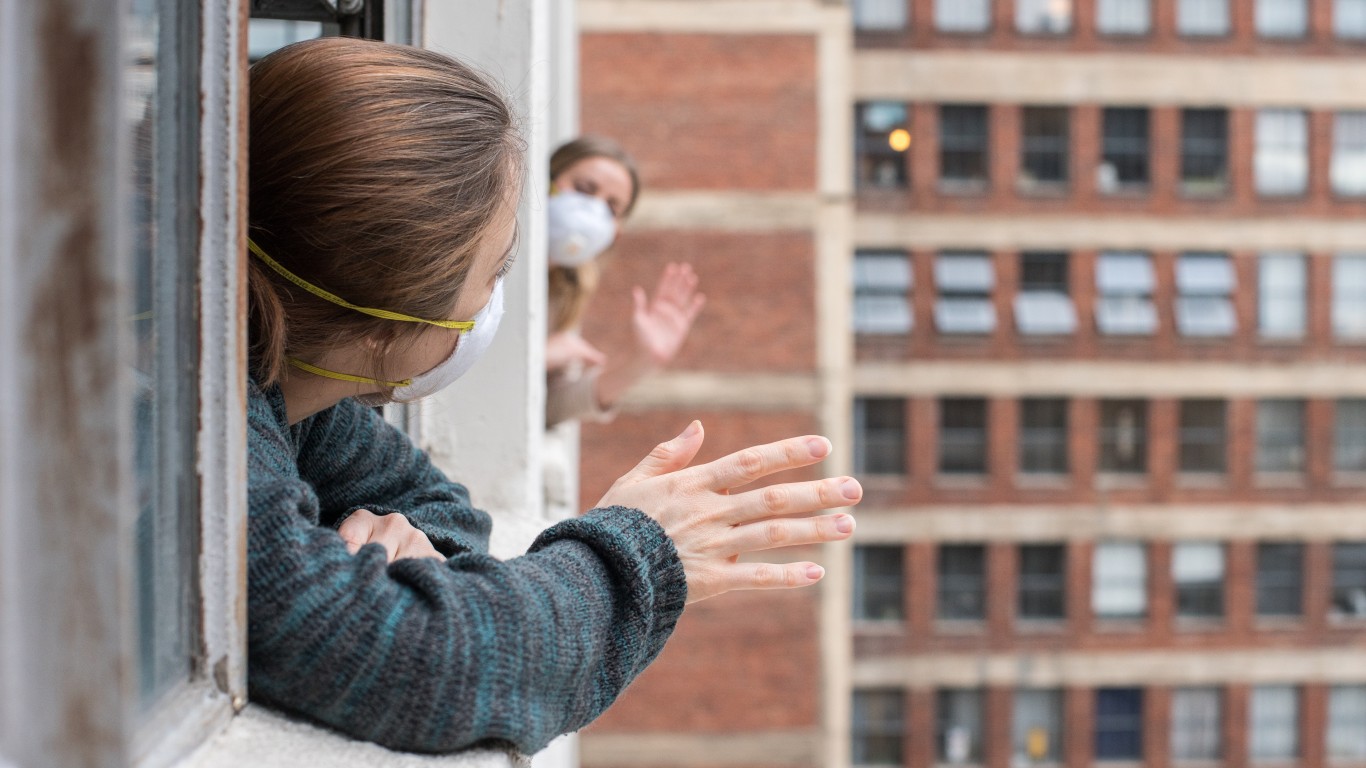 24/7 Wall St.
24/7 Wall St.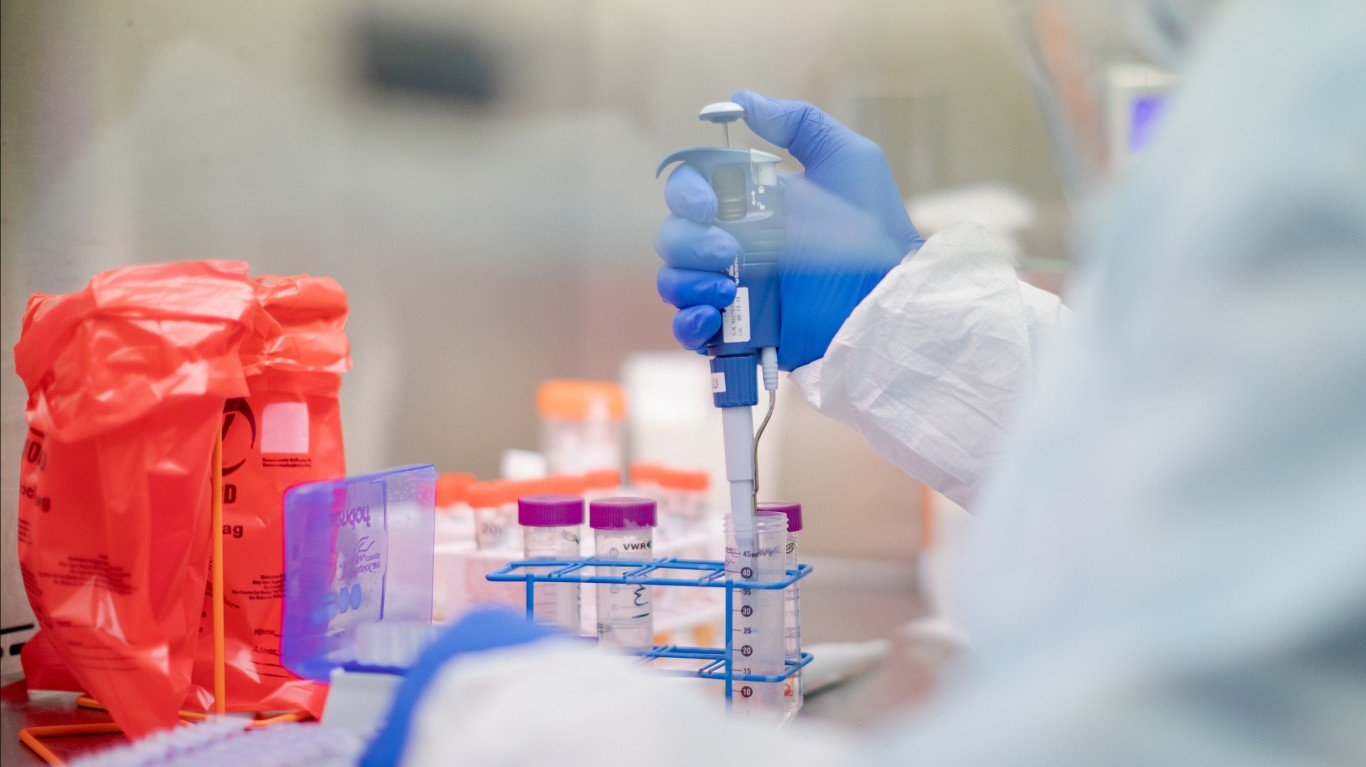
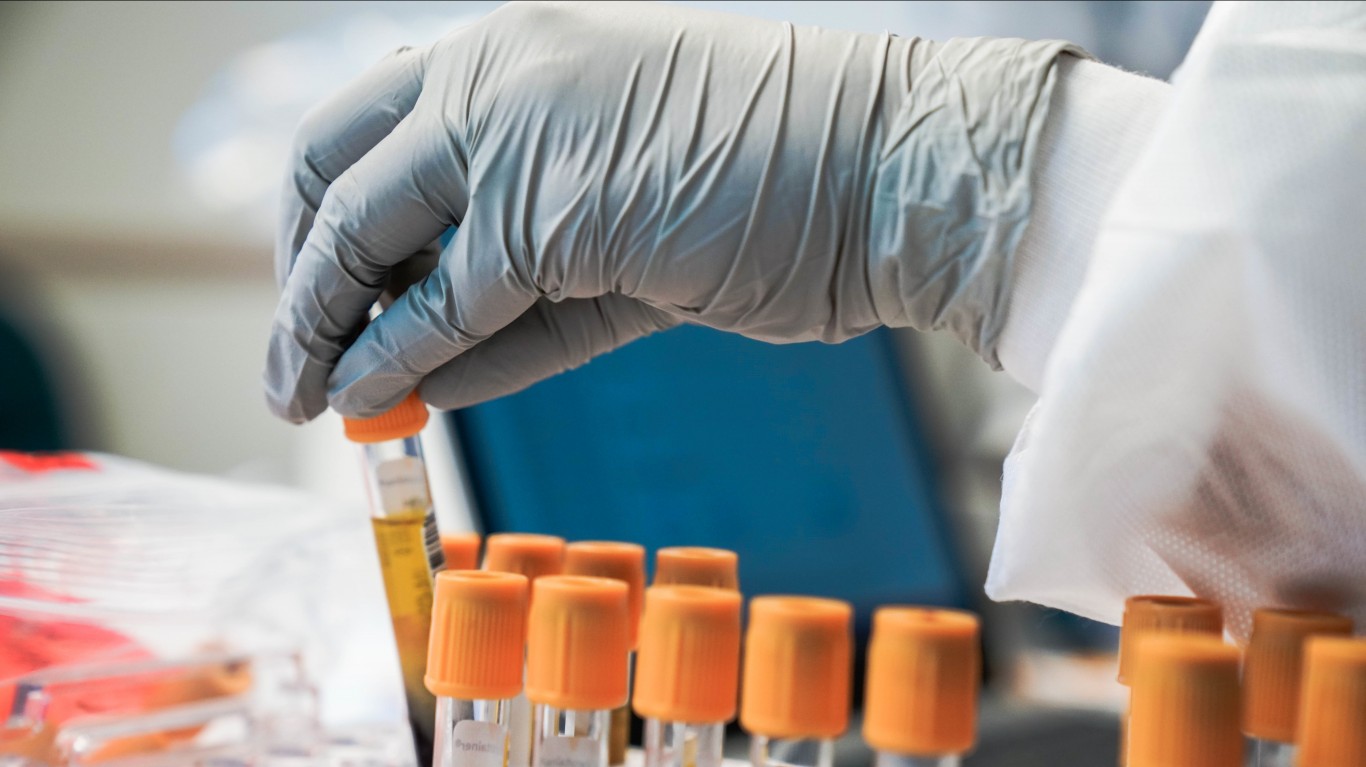 24/7 Wall St.
24/7 Wall St.